#and to remake his character purely for a metaphor?
Explore tagged Tumblr posts
Text
See, this? This is why I don’t like their version of Miguel.
Because Miguel O’Hara, in his original run, was, in effect, bitten by a radioactive corporation. Unless he fell in line and kept being unethical (and turning people into living soup), his boss wouldn’t keep up the supply of the super-drug (highly addictive) that he’d roofied Miguel’s drink with to keep him with the company. That’s why Miguel became Spiderman in the first place—it was supposed to cure him of the drug and nothing else, and then a guard who had no idea what Miguel was doing interfered with the process. And since that day, since being transformed into effectively a monster, Miguel has been actively fighting against those corporations and what they do to people, alongside his usual roster of (actually quite dark) villains. Because he doesn’t want it to happen to anyone else.
“With great power,” to Miguel O’Hara, “comes great guilt.”
And look at him now. Injecting himself daily with spider-powers to ward off the damage the Rapture is doing to his brain, that was a nice touch. Defeated and traumatized by destroying a universe, well, that’s one thing. Panicking because the anomalies seem capable of causing reality to be destroyed, that’s another. But maybe I haven’t read the original comics enough, but it seems very much out of character for the man not to try to find the craziest solution possible for such things. To try and assuage the guilt that keeps creeping up with his power instead of sticking to a rut. Guilt drives the man, sure, but guilt that lets him find solutions, ways to bend or break the rules without getting people hurt.
Comics Miguel, methinks, would be more likely to completely ignore Movie Miguel’s attitude and go save Miles’ dad himself. Or work with Gwen to expand the loopholes. (What happens if a police captain is declared dead because he’s on a quick stay in Nueva York, sitting in Spider-Therapist’s room with his son going through the revelation of a couple of things? Why the hell would Miguel not use that as a general loophole?) Or just get his Lyla to systematically prove that the glitch-spots are to do with something far removed from the Canon—something darker.
(Perhaps the life of Peter Parker, whose mere presence in the Collider was able to summon five Spiders, had its whole history spread across the Web as a template. Perhaps it’s influencing events so they appear “canon” by coinciding with what the other five—six—Spiders have had to go through. And to go “beyond” the Spider-Verse means cleaning the influence in the Web from those six first Spiders.)
I’ve never liked The Canon as a concept. There’s too much it leaves unclear as to what the Spiders can actually do, and makes no mention of any good things in their lives. But taking one of the few Spiders who actually actively hates authority, and for damn good reason, and putting him in charge of a hundreds-strong team that isn’t willing to make a difference in the lives of people like them?
“Oh, shock, I’m turning into my father.”
oh miguel o'hara is a corporate metaphor
he's corporations telling people what they can and can't be (big media companies telling artists what they can and can't make)
I can't believe it just hit me hobie literally says fuck capitalism
#spiderverse#miguel o'hara#across the spiderverse#spiderverse spoilers#no but seriously#Miguel O’Hara was the sort of Spider to literally make public announcements against corporations and destroy their property#he and Hobie should be getting along waaaaaaay better than they do#and to remake his character purely for a metaphor?#not just remake but *reverse* his character#one more reason the sequel really disappointed me
7K notes
·
View notes
Text
ok I'm just gonna elaborate on my opinion that the remake of "Cloudy…with a chance of murder" is The Most Evil And Fucked Up Thing Psych Creators Could Ever Do Because Of The Bike Scene Removal y'all remember the "I've been thinking about getting a car" speech right. But let's take a step back and talk about the bike.
The bike symbolizes Shawn's freedom, independence, and in the "Cloudy…" it is implicitly taken by his own father ( which I'm letting go. for now), and in the end a bunch of people prepared to get it back for Shawn, but who gets there first? Lassiter. And it would be SO easy to play it off by having Lassie say something like "I got you your bike back so you could drive the fuck away from my police station", or "you helped me out before so I feel obligated to repay you, now we're even", but no. Lassie's reaction is genuine embarrassment when people found out he got the bike, because it was purely a nice gesture. A nice gesture for Shawn, whom he "hates". So what I'm saying is. metaphorically. Lassiter gives Shawn back all the independence and freedom, because despite all Shawn's antics, he sees him and accepts him for who he is, with all his bullshit, doesn't fall for his lies and literally embraces the deception and rolls with it for eight more seasons, with occasional Gotta Call Him On His Bullshit To Keep Him In Shape. This scene encapsulates the progress of the dynamic between Lassie and Shawn and it's the foundation for their future relationship, where they know they can trust and rely on each other, despite everything. So again, removing it in the remake was a literal crime against humanity and me specifically because it basically erases part of Lassie's character
#psych#psych tv#I'm gonna write a whole ass scientific paper about the significance of transport in psych i swear to god#bc obviously we have the blueberry that's tied to gus#and we have the car that shawn stole#WHICH ALSO THE CAR THAT INDIRECTLY WAS THE REASON LASSIE AND SHAWN FIRST SAW EACH OTHER#and the thing about Shawn's monologue with jules. is that he does get a car#which is also the car that he stole all those years ago#which again#tied to his first meeting with Lassie THEY ARE MEANT TO BE-#anyway#that car can be! driven! by! two! people!#and of course he drives it with gus. of course#but who else also gets to be in the front sit?#SBPD chief Carlton J. Lassiter#they are DRIVING. TOGETHER. THE CAR. THAT SHAWN GOT. ALL THOSE YEARS GO. BUT “ROAD” IS LIFE. AND THEY`RE TOGETHER. DRIVING.#DO YOU SEE WHAT I MEAN. DO YOU SEE WHAT I'M GETTING AT#anyway im done. carlton and shawn are kismet in every conceivable way ty for coming to my ted talk
352 notes
·
View notes
Text
“Sacrifice” and “Covenant” in “Nosferatu” (2024)
Or: how Robert Eggers took the “bride of Dracula” theme to the next level, and no one noticed? And how his adaptation of “Nosferatu” is so widely different from the previous ones? Let's make cinematic comparisons.
First things first: “Nosferatu” and “Dracula” are the same thing. The silent 1922 German movie “Nosferatu: A Symphony of Horror” was an unauthorized version of Bram Stoker’s 1897 novel “Dracula”, and Stoker’s widow even sued the film makers and won, and all copies should have been destroyed but made its way to the US, and the rest its history.


Count Orlok is Count Dracula; Ellen Hutter is Mina Harker; Thomas Hutter is Jonathan Harker; Knoch is Renfield; Bulwer/Von Franz is Van Helsing; Anna/Ruth Harding is Lucy Westenra, and Friedrich Harding is Arthur Holmwood.
The relationships between these characters are the same in the 2024 adaptation; Mina/Ellen and Jonathan/Thomas are married, Lucy/Anna and Arthur/Friedrich too. Von Franz/Van Helsing is called to help against Dracula/Orlok. And Renfield/Knoch is Dracula fanatical servant who wants immortality. Why Dracula wants the female characters (Mina and Lucy) varies from story to story: in some he only wants their blood, in others he wants them as his brides.
In the 1922 version, Orlok brings plague and rats to an European city, and unlike Dracula, his victims don’t turn into vampires, they just die. There is also no “brides of Dracula” here. This is also the case in the 1979 adaptation.
To analyze the 2024 adaptation of “Nosferatu”, we need to have this in mind.
Cinematic context
"Nosferatu" adaptations
The climax of the “Nosferatu” story is Ellen Hutter (Mina Harker) sacrificing herself to save Wisburg, because she reads a book that says a vampire can be defeated if a pure-hearted woman distracts him from the approaching dawn with her beauty and by offering him her blood of her own free will.
This is what we see with the 1922 and 1979 adaptations (yes, I’m ignoring the 2023 remake because it’s almost a rehash of the 1922 film):

Nosferatu: A Symphony of Horror (1922)
This woman is already dead. Rest in peace in advance. She’s on her back, she completely accepted she’s not getting out of this alive, and she’s selflessly sacrificing herself.

Nosferatu the Vampire (1979)
The same vibe as the first + unnecessary boob grab. This adaptation uses the Bram Stoker names, but she’s “Lucy Harker” (not Mina), and is married to Jonathan Harker (Thomas Hutter).
These women are metaphorically and literally “sacrificial lambs” in these scenarios, there’s no doubt about it. They just lie there, at the mercy of Orlok/Dracula, waiting to die, and for the sun to rise and kill him. But more on that later.
"Dracula" adaptations
There have been so many “Dracula” adaptations in cinema and television, it’s impossible to address them all in this post. This story has been told and retold so many times already, from horror to comedy to drama to romance. We had the brides, the daughters, the sons and even the granddaughter of Dracula. The list is endless, cinema and television has gone through all of Dracula family already.
The most iconic cinematographic adaptations of “Dracula” in cinema history (even though some have no resemblance to the actual book), besides 1922 “Nosferatu” are: “Dracula” (1931); “Horror of Dracula” (1958); “Dracula” (1979) and “Bram’s Stoker Dracula” (1992).

Béla Lugosi 1931 Dracula pretty much solidified Dracula iconography in pop culture
These films are considered cult classics mostly because of their cast (Béla Lugosi, Christopher Lee, Frank Langella, Gary Oldman) and legendary directors (Francis Ford Coppola).
In this story, Dracula is usually killed by a hero male character (Van Helsing, Jonathan Harker, Arthur, Quincey, etc.), which is what happens in the novel. “Nosferatu: A Symphony of Horror” (1922) introduced his death at the hands of a female character (Ellen/Mina), even if indirectly (distracting him until dawn so the sun can kill him). “Bram Stoker’s Dracula” (1992) is the exception to this rule, with Mina being the one to kill Dracula at the end, to give him peace (which probably explains why there are so many references to this film in Robert Eggers’ adaptation).
"Her willing sacrifice thus broke the curse"
The main differences between the 2024 adaptation and the previous ones is, indeed, Ellen Hutter and Count Orlok psychosexual connection (like Robert Eggers himself has said) and Ellen’s entire character.

In previous adaptations, Orlok took an interest in Ellen because he saw her portrait (which Thomas Hutter carried with him). In 1922, he wanted her blood, because she’s pure of heart (metaphorical “sacrificing a virgin to the Devil”, probably), and in the 1979 adaptation, he wants the love Jonathan has, but he, himself, can't ever have.
In the actual novel, Dracula bites Mina and wants to turn her into a vampire as revenge (she’s the one who uncovers his plans). Mina Harker is also the literary antithesis to the “she-vampire”, she represents the pure and virginal Victorian woman.
This is also the case with Ellen Hutter’s character in the original 1922 “Nosferatu”, and the reason why she’s the one who selflessly sacrifices herself to save the world from Nosferatu curse. It's her purity which allows her to do this. She’s almost Christ-like, taking this role for herself after reading about it in a book.

In the 1979 adaptation, Lucy/Ellen is the one who can defeat Dracula/Orlok because he’s in love with her, and she weaponizes that to bring him to his destruction. Like the 1922 film, Lucy is also the one who discovers how to defeat Nosferatu. But unlike 1922 Orlok, this vampire is a tragic, depressive and pitiful creature, tired of immortality and loneliness, who takes no joy in the destruction and death he brings.

This is not the case in the 2024 adaptation. Eggers’ Ellen does not represent the “pure and virginal Victorian woman” and as such her “sacrifice” at the end can’t possibly have the same meaning as previous adaptations of this particular story. Because that’s not how storytelling works, and why many are scratching their heads at this ending. The film itself talks about “sacrifice” to “redeem” the townsfolk of Wisburg and save them from Nosferatu curse/plague, but why?

Eggers’ Ellen is a subversion of Mina Harker/Ellen Hutter character. She’s not the God-fearing, devoted and pure-hearted Mina, neither she tries to be. She’s ostracized by society, she doesn’t fit in, she’s been diagnosed as a “somnambulist hysteric melancholic” (hiper-sexual depressive sleepwalker), it’s implied she has been institutionalized (probably in an asylum) before. She outright rejects God and His intervention when talking to Anna about life (it’s destiny, not God). There’s a lot of crosses in this film but none are around Ellen’s neck. She loves Thomas but wants more passion and hunger from him. This is a completely different character from the OG Ellen Hutter/Mina Harker.
On a superficial level, it appears Ellen takes advantage of Orlok sex blood lust to bring him to his own destruction (he’s an appetite who can’t be satisfied without her… blood?), a mix of the 1922 and 1979 adaptations? However, this explanation is not “it” because of a not so smaller detail: their covenant (almost everyone keeps forgetting for some reason). Which didn’t exist in the previous films, this is a plot Robert Eggers introduced but has no pay off?
To me, it’s clear. This talk of “sacrifice” is a red herring and a MacGuffin in the narrative, and it doesn’t mean anything, it’s irrelevant. It’s just there as a Easter egg and reference for previous adaptations of this story. And the true Chekhov's gun of the story is the covenant between Ellen and Orlok. What is a narrative “Chekhov's gun” you ask? It’s a plot that’s introduced early in the story, and whose significance will only became clear later.
Why not the other way around? Because all the foreshadowing of the story points to Ellen joining Death (Orlok), not only freely (out of her own will), but how happy she is in doing this. Hence her dying alongside Orlok at the end can’t possible be an actual selfless sacrifice to save Wisburg or Thomas, nor is she a “sacrificial lamb” like the previous adaptations of this story. There is zero foreshadowing for this happening. Them both (physically) dying in a context of a covenant has to mean something else in this story.

Also the fact that Eggers’ Ellen and Orlok have an entire backstory going on between them, which is also unique to this adaptation. Here, it’s Ellen who “awakes” Orlok from his grave with her summoning prayer, in her teenage years. The guy has been dead for centuries until she brings him back, basically.

She develops a spiritual connection with him, which turned sexual (what we see in the prologue is their relationship already developed, when Orlok reveals himself).
“At first it was sweet, I had never known such bliss. Yet it turned to torture, it would kill me. [...] He is my shame! He is my melancholy! He took me as his lover then, and now he has come back. He has discovered our marriage and has come back!”
“Remember how once we were? A moment. Remember?”

We also have the whole ordeal with the lilacs, throughout the film, which are meant to represent Ellen and Orlok's relationship.
A little historical context here for “Ellen’s shame”: this story is set in the Victorian era, where women weren’t supposed to have any sexual desire whatsoever, and even within marriage they were supposed to be modest and restrained. Ellen engaging in sexual activity without being married is highly scandalous for Victorian society (it has nothing to do with “abuse” or whatever wild inaccurate historical interpretations are out there.)
In the novel, Mina does develop a mental connection with Dracula as a consequence of him biting her and feeding her with his blood (cursing her to vampirism). This allows the heroes to track down and destroy Dracula. In the “Nosferatu” adaptations, this connection is more related to Jonathan himself. The only adaptation I can recall that has this sort of astral fuckery going on is “Bram Stoker’s Dracula” (1992), with Lucy's character.

The Covenant
Orlok: “You are not for the living. You are not for human kind. And shall you be one with me ever-eternally. Do you swear it?” Ellen: “I swear."
The thing is: vampires in this “universe” (sort of speak) aren’t made like in the original “Dracula” novel and every vampire story ever since (where the vampire bites and feeds his blood to another, and turns them into a vampire). Orlok victims don’t turn into vampires, they just die. So, what does this “covenant” mean, and implies?
We have to look into the other character in the story, who also wants to make a “covenant” with Orlok, and is his fanatical servant: Herr Knock (our Renfield).
“The compact commands she must willingly re-pledge her vow. She cannot be stolen.”
First piece of information: this "covenant" ("compact"; "pact") has to be made of free will.
The next clue we got is when Von Franz and Dr. Sievers break into Herr Knock’s office and find books and a cryptic writing:
“His thunder roars from clouds of carcasses, I feedeth on my shroud, and death avails me not. For I am his.”
“Thunder roars” and “clouds of carcasses” appear to be a reference to Orlok? Or to other deity? “I feed off my shroud and death is of no use to me, because I’m his”: seems to be what this means.
Von Franz also finds out Orlok is Solomonari, student of the Devil (from Romanian folklore).
Later, Von Franz studies the book he took from Knock’s office, which contains the instructions in how to defeat Orlok: “And so the maiden fair did offer up, her love unto the beast, and with him lay, in close embrace until the first cock crow. Her willing sacrifice thus broke the curse, and freed them from the plague of Nosferatu.”

When Thomas, Von Franz and Dr. Sievers go to Grünewald Manor to destroy Orlok’s sanctuary, it’s Knock on the sarcophagus, and Thomas stabs him with the iron spike before he can see him. And he wants to be killed, as he pushes the stake deeper into his body:
“I relinquished him my soul. I should have been the Prince of Rats – immortal... but he broke our covenant... for he cares only for his pretty bride [...] She is his! [...] Strike again. I am blasphemy!”
Knock's final words are: "Deliverance." Which is... odd to say the least, because “deliverance” has Christian religious meaning with “salvation”, or even “exorcism” (“deliver us from evil”). But it also means “to be set free”. Interesting enough it’s what Von Franz tells Thomas to do, before they open the sarcophagus: “Go forward Thomas. Set free the daemon’s [demon] body!”
In 1922 “Nosferatu”, Knock remains loyal to Orlok until the bitter end, and even tries to warn him about the rising sun while he’s feeding off Ellen. He also dies as a consequence of his master’s death. In the 1979 adaptation, he leaves before any of this happens, so there's no point talking about that in connection to this.
This leads me to a few questions:
Why would this fanatical follower of Orlok have a book in how to destroy his master, on his own office? In previous adaptations, this knowledge was with "good" characters, not with the second antagonist of the film;
Why does Knoch wants to be killed? Nothing in his character suggests he had a "chance of heart" or is seeking punishment for his “sins”, or absolution, or anything of that sort;
And if 2024 Knock is loyal to 2024 Orlok, until the bitter end (like his 1922 counterpart), what does this mean for the narrative?
The obvious explanations are: (1) Orlok ordered Knock to have that book there for the “vampire hunters” to find and let him have Ellen; (2) or it’s one of those extraordinary coincidences where one of the villains just “kind of forgot”, which seems extremely unlikely in a movie that has been in preparation since 2016.
This also tells us, Orlok might have prepared his own physical demise (because not even demons want to be a rotting corpse, probably), so his soul is set free and returned to Hell? the Underword? Some astral place other than the material/physical world, where he's forced to be a walking corpse. And he wants to take Ellen with him.
As the abbess tells Thomas:
“A black enchanter he was in life. Şolomanari. The Devil preserved his soul that his corpse may walk again in blaspheme.”
This is a horror supernatural film, physical death means nothing in this context, where demons, ghosts and vampires exist. Physically killing Orlok, will only set free his spirit, really.
Harding: “I cannot yield to being haunted by some ghost!” Von Franz: “No, no, no, please, no. It is no mere ghost, for it can manifest physically, and with the most foul intent.”

And so, we return to the cryptic text Von Franz found in Knock’s office (“His thunder roars from clouds of carcasses, I feedeth on my shroud, and death avails me not. For I am his.”). Like Orlok, he sold his soul to the Devil and isn’t afraid to die, because he knows he’ll return as a vampire. And death appears to be a part of this pact, as well. Only, he’s killed by a iron spike and his corpse set on fire, so… there’s no coming back from that.
“Clara asked me today if Aunty Ellen has become a ghost.” Anna tells Friedrich, foreshadowing Ellen’s fate (these kids are like “foreshadowing bombs” in the narrative)
Bride of Dracula/Orlok
“He cares only for his pretty bride [...] She is his!”
“And shall you be one with me ever-eternally.”

Come on, it doesn't get more obvious than this.
Orlok: “Do you accept this, of your own will?” Ellen: “I do.” Orlok: “Then the covenant is fulfilled. Your oath re-pledged.” Ellen: “Yes.” Orlok: “As our spirits are one, so too shall be our flesh. You are mine.”
I already explored why Ellen and Orlok are “fated” and why she’s “promised” to him in another post, so I’m not going to talk about that topic here.
It’s “Bram Stoker’s Dracula” (1992) that established Mina as Dracula’s lover and bride (and reincarnation of his wife) in pop culture (not sure if it was the first film to actually do this, but in previous decades it was Lucy’s character, not Mina, because she’s the one who’s more progressive and liberal). Not only that, but this Mina is more complex and "grey" than previous adaptations: “Perhaps, though I try to be good, I am bad. Perhaps I am a bad, inconstant woman.”
This film had such an impact and it’s so iconic, it has spawned several similar stories in its aftermath.

"I've crossed oceans of time to find you." Dracula to Mina, "Bram Stoker's Dracula" (1992)

“I have sought a creature from the depths. A Eve that remembers her Eden. You are such one.” Orlok to Ellen, "Nosferatu" 2016 script (too bad Eggers didn't keep this)
There is no way Robert Eggers wasn't inspired by Coppola's adaptation of “Dracula” to create his own version of “Nosferatu” (even if he doesn't acknowledge it, publicly), only more demonic and macabre, and less "on-your-face-romance". He went with the dark and gothic route. Dracula tells Mina: “Then I give you life eternal [...] Walk with me, to be my loving wife, forever.” Plus: “to walk with me you must die to your breathing life and be reborn to mine.”
And Van Helsing very dramatic line about Lucy: “She is a willing recruit, a breathless follower, a wanton follower. I dare say, a devoted disciple. She is the devil's concubine!”
And both Ellen and Mina saying “I’m unclean!” because of their connections to Dracula/Orlok.


Only Orlok's “eternal life” is death, in this adaptation. So, Ellen must die in order to join him and be one with him “ever-eternally” aka complete and fulfill their covenant. She's relinquishing her soul to him, she is the “devil’s concubine”. "You are mine."
Ellen is very much aware of what’s she’s signing for here. She knows she’ll die and she’ll be with Orlok forever, in the spiritual world. Odd thing to do if hatred is the only feeling she has for him, or if she’s doing this to save others.
Yes, her “willing sacrifice” saves the world from “Nosferatu curse” but that’s not exactly the point, it’s more of a colateral, a consequence. But at no point in this film this “sacrifice” is described as “selfless” from her part. She’s the one who says to Von Franz she “needs no salvation” and all of her life she has been true to her nature. Which is what happens at the end, as she embraces her own wickedness (“does evil comes from within or from beyond?”).
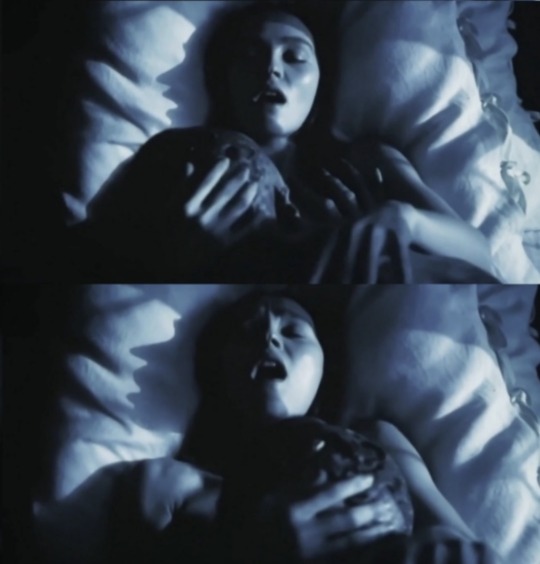
2024 Orlok is unapologetic evil. He makes no excuses for his behavior, nor he rationalizes his own actions. He’s not a tragic, romantic nor a tormented figure. He’s an appetite, a beast, a devil, and he doesn’t conceal his own nature. Which is what Ellen herself reconciles with, at the end. By accepting him, she’s accepting herself.

2024 Ellen entire demeanor and behavior in her final scene with Orlok is completely different from previous adaptations. She’s not lying there like a “sacrificial lamb”, at all. Not only she’s getting sexual pleasure out of this, she embraces him as the sunlight kills his physical form, and he’s suffering, and in terrible pain, until they die in each other’s arms. It doesn’t get more horror gothic romance than this.

She wouldn’t have any reason to act this way if this whole ordeal was a mere “selfless sacrifice” to save everyone else, like in 1922 and 1979: where Ellen and Lucy are just there waiting to die and not caring less about Orlok/Dracula pain under the sun, because they want to destroy him. In the 2024 adaptation, Ellen is silently and tenderly comforting Orlok as he dies, instead, compelling him to look at her. They are acting like lovers in a suicide pact, nor as prey and predator.
And I have to laugh when I read folks saying this film finally made justice to Mina/Ellen and Jonathan/Thomas love story from the “Dracula” novel, because Robert Eggers not only made another cinematic addition to the whole “Dracula x Mina” universe, but he took it further than Francis Ford Coppola by having them actually ending up together, forever united in some spiritual realm.
“The VVitch”
And this ending of "Nosferatu" is not surprising coming from Eggers, because this is almost the same ending as "The VVitch" (2015), and he started to working on this script after that movie.
“The Devil is in thee and hath had thee. You are smeared of his sin. You reek of Evil. You have made a covenant with death. You bewitched thy brother, proud slut! Did you not think I saw thy sluttish looks to him, bewitching his eye as any whore? You took them from me! They are gone! You killed my children! You killed thy father! Witch! WITCH!” Thomasin's mother accuses her.

Black Phillip/Devil: “Wouldst thou like the taste of butter? A pretty dress? Wouldst thou like to live deliciously?” Thomasin: “Yes.”
Thomasin was accused of being a "witch", a “whore” and having a pact with the Devil by everyone around her, until she actually became one at the end. It's pretty much the same with 2024 “Nosferatu” Ellen: she was also seen as “deranged”, “diseased” and often compared to supernatural beings ("changelling girl", "sylph", "fairy", etc.) until she became just that at the end, too.
#Nosferatu#nosferatu 2024#Nosferatu 1922#Nosferatu 1979#count Orlok#Ellen hutter#Thomas Hutter#dracula#Bram stoker Dracula#Robert Eggers#bram stoker#francis ford Coppola#lily rose fell#bill skargard#ellen x orlok#orlok x ellen#mina x dracula#dracula x mina#the vvitch
234 notes
·
View notes
Note
Since I asked you about Sephiroth, I also wanted to ask about what you think of Aerith’s character and her characterization throughout the franchise.
Hhh oh god. Yeah.
So, again, Aerith begins in Final Fantasy VII as a seemingly intentional semi-subversion of the Princess Holy Maiden White Mage JRPG trope.
Mechanically she is absolutely a classic white mage, but she's also a street kid with way more life experience than Cloud, who both connects instantly with him due to his similarities with Zack, her dead ex (because, of course, Cloud is directly copying Zack's entire personality), but she also notably pushes back against him, and repeatedly refuses to let him treat her like a damsel in distress, and takes direct agency over where the story is going and what's going to happen.
As she becomes more and more conscious of her Magic Special Lineage, she changes, of course, and... arguably falls a bit more into a straight rendition of the Holy Maiden trope. Albeit I have always quite loved the reveal that Aerith isn't killed by Sephiroth just as a big tragic fridging to advance the story through Cloud's pain, but as an intentional gambit on her part to ultimately defeat the villain. The translation of the game is famously a bit wonky, but my reading of the story is that she
realizes that Sephiroth is manipulating Cloud as his primary agent in the world and that she needs to get away from him
realizes that in order to cast Holy and defeat Meteor she needs to enter the Lifestream, so
she manipulates Jenova/Sephiroth into killing her in the one place on the Planet that has the strongest connection with the Ancients so she can take advantage of their knowledge to figure out how to make Holy work.
It also kinda seems to me like she realizes that Cloud is the best chance the planet has of a champion who can defeat Sephiroth and unblock the Lifestream for the Holy spell, and maybe she sacrifices herself in part in the hopes of breaking Cloud out of Sephiroth's influence. which, yeah, that is definitely some fridging-trope nonsense.
The original game absolutely isn't perfect on how it handles it, but Aerith is (especially for the late 90s) a remarkably active player in the story, with a lot of agency entirely separate from the male protagonist, who comes into a role that requires her to separate herself from the main party and go off to set her own plans into motion.
I am overall less fond of how she got portrayed in media after the original FF7, where she really did seem to get boxed into an entirely unironic Holy Maiden trope - especially by Advent Children which casts her as a literal lover/mother to Cloud, whose especially pure and holy influence heals the blight of Geostigma once her darling Cloud overcomes his personal conflict. And certainly, a lot of portrayals of Aerith I've seen tend to focus way more on her mystical, divine Cetra Chosen One-ness than on her actual upbringing as a scrappy sassy street kid.
The Remake games... have generally walked the line okay, I think? Aerith with the steel chair might genuinely be my favourite gif from any videogame ever,

(she's just so happy to be beating the shit out of this man)
although I do feel like her portrayal in those games make her a bit too much of a Love Interest To The Protagonist character. I feel the balance in the original focused a lot more on her coming into an understanding of her role in the story separate from her attachment to Cloud, but I also have massive nostalgia glasses on my face about Final Fantasy VII, so I recognize that I am biased here.
I'm curious how the Remake trilogy, which is a wild metacommentary on the legacy of its own original, will ultimately handle her, and I really do hope it doesn't confuse the idea of a "good ending" for Aerith with the idea of being romantically paired up to a male character, or with the idea of literal or metaphorical motherhood or some other bioessentialist nonsense.
174 notes
·
View notes
Text
Halloween Film: Invasion of the Body Snatchers (1978)
I always loved the ending of the 1956 Invasion of the Body Snatchers, the classic sci fi film about replicant humans being grown from strange alien plant pods and taking over society. Well, I loved what was the ending, before the nervous studio tacked on a prologue and epilogue giving the film an optimistic (and contrived) conclusion. You know, where the main character runs out onto the road, desperately trying to halt oncoming traffic, to get anyone to listen as he cries, into the night, and finally directly into the camera at the audience, "They're here! You're next! YOU'RE NEXT!" For all the film's been interpreted as expressing red scare paranoia about communist infiltration (and even that's contested--others see it as a cry against McCarthyite witch hunts), the sheer manic shrieking energy of that finale lodged itself in my brain ever since I watched the film as a teenager. It was fearful, but it also was relatable, almost a kind of perverse power fantasy. Imagine, just imagine, screaming out from every theater screen and tv set: don't you see what's happening all around you? Look away from the screen if you like--they're already here!
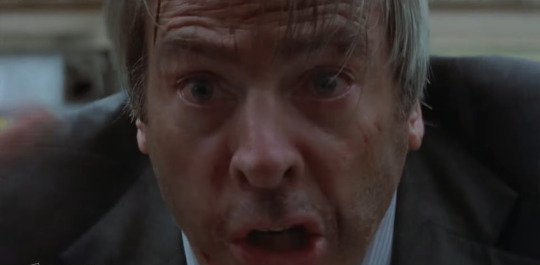
The 1978 remake is actually a weird kind of precursor to our new phenomenon of the rebootquel: a short ways into the film, the main character of the original (literally--it's Kevin McCarthy, the original's star) slams into the car of our protagonists, ranting that blood curdling monologue. In this version, however, the pod people swiftly dispatch him off screen, and we get a creepy shot of a crowd of them standing silently, dispassionately, over his bloody broken body. That sums up the film's sense, contra the original, that it will already be too late by the time anyone notices anything wrong.
What a creepy film this is. It's astonishingly shot, full of striking images and brilliant camera work. Like, if you want reflections and shadows and distorted views of characters to feel fresh again, like they're more than hackneyed metaphor but really, viscerally unsettling, this is the film for you. There's a pervasive sense throughout that the worst has already happened, the world already gone strange when you turned your back. Instead of zombified mania and violence, there's a flatness to everything, a cool impassivity. The cast enhances this impassive flatness through contrast: it's a film full of brilliant weirdos as heroes. Scope Jeff Goldblum in this, for example, as a self absorbed neurotic owner of a mud bath house, and Veronica Cartwright as his Star Child wife. Even the relatively well adjusted main couple has their oddities: early in the film Brooke Adams as Elizabeth has a moment where she does this, fuckin, crazy thing with her eyes to make her friend Matthew laugh that's genuinely very funny and unsettling, and it immediately lends her character so much off beat humanity. These are people who have dedicated their lives to the department of health and they've got the zealotry that comes from being genuinely a bit of a weirdo for both bureaucracy and science. Indeed, Elizabeth's husband gets replaced early in the film by a pod she brings home to study out of pure curiosity about the world.
Elizabeth, soon after realizing there is something fundamentally wrong and alien about her husband, remarks to Michael that San Francisco feels suddenly strange to her, like an alien environment full of alien people. I feel this sometimes in Seattle. Oh, everywhere, but pronouncedly here, interacting with boomer or gen xer artists in my area who casually talk about the homeless like they're subhuman, with people on the street who will freely monologue about who we need to cleanse from the city, with our repulsive mayor and city council who verifiably think I and queers like me are disgusting. You get to thinking, or at least I do, that surely people don't have that much cruelty in their heart, and then you run up against the flat casual way a stranger will condemn a fellow human to oblivion, simply for the crime of being an unpleasant reminder of poverty. Every supposed red line gets crossed--local leaders pump money into already bloated police budgets, people shed their masks, politicians race to be the most xenophobic and border-paranoid, and the state department and media shovel dirt on the fire of each exploded Gazan hospital or butchered aid convoy. Am I supposed to feel secure in this tough new environment? All I hear is the panicked cry: YOU'RE IN DANGER! YOU'RE NEXT!
Donald Sutherland's character Matthew has a belief in institutions that's at once charming and completely exasperating. He's a health inspector who clearly cares deeply about doing his job and doing it well, and so is almost totally unequipped to respond when every social system transforms into a weapon to hunt and replace him. The number of times this man calls the police, often seemingly out of civic duty!! Meanwhile Leonard Nimoy plays a psychiatrist who manipulates and shepherds the cast. He's a pod person, of course, but it's totally unclear whether he was one the whole time or became one late in the film. The suggestion seems to be that it doesn't matter: his role as a professional is to smooth over social ruptures and keep the state of things running as stress free as possible, so he seamlessly adopts his role in the new dispassionate world order. I can't stop thinking, too, about a scene where Matthew and Elizabeth are caught out pretending to be pod people because they react with terrified revulsion to a homeless man who's accidentally been grotesquely fused with his pet dog. The pod people, of course, do not react to this sight, but go about their business. All that seems to have changed in pod person world is that the whole machinery of society carries on without emotion or meaning. The horror is that instead of ending, the world just keeps going.
Sarah and I discovered after watching that there's two other takes on The Body Snatchers, one in the 90s and one late in the Bush era 2000s. I guess that means we're about due for a new generational interpretation of the story. It's not quite like clockwork; maybe it's more like a seasonal bloom. Every 10-20 years, someone feels a compulsion to run to the cinemas and shout, to anyone who will listen, that they're already here, the pod people have already taken over while we were sleeping. And maybe they already have.
Check out more short reviews on my Patreon
#invasion of the body snatchers#horror#horror movies#horror review#movie review#halloween#spooky season#jeff goldblum#donald sutherland#brooke adams#veronica cartwright#leonard nimoy
28 notes
·
View notes
Text



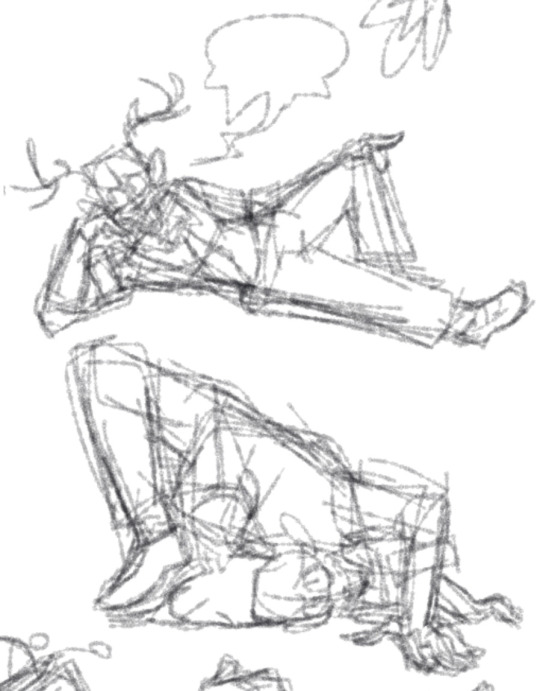
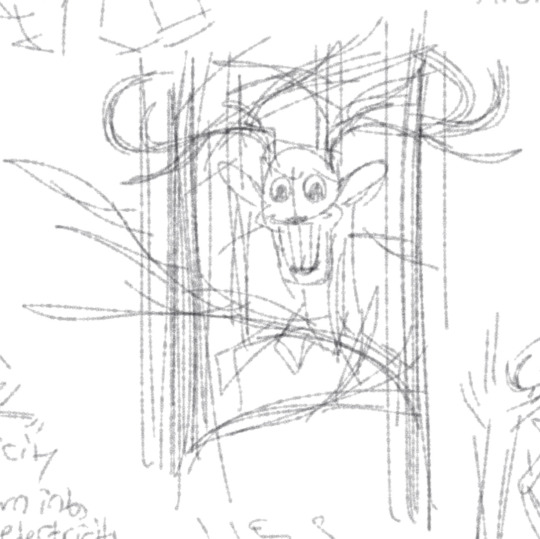
Playing around with Alastor’s design a little bit. He would still wear most of the same outfit he wore back then, don't fix what's not broken, but with an added suit jacket that's a bit too big for him. I need to make a bit of to at some point, but after his break up he draws on a pencil mustache to add on to his emphasis of having a new appearance while still staying in his time.
A post depression mustache if you will.
As for some of his creepy aspects I'm cutting out the voodoo elements of his character, and instead using the uncanny and analog horror elements instead (I am a simple creature).
I need to actually remake the color pallets for him and old Vox, but essentially they both start off as black and white or with grey like colors, and gain new ones after they split up. Vox becomes more saturated and Alastor becomes sepiatone, as while it's more colorful it's still is reminiscent of the past.


Now time for some of the silly rivalry bits:
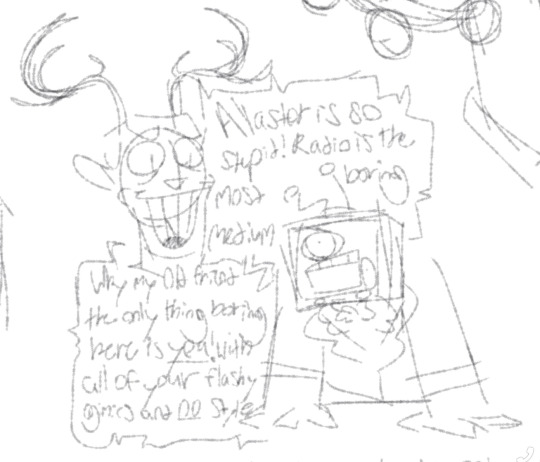

I’d image they would have casual debates on the radio and tv that would soon devolve into insults and eventually nothing but 30/50s slang and Creole French that would last for hours.
I need to finish writing this bit, but basically Charlie sees it as a good idea to go on Vox’s talk show to promote the hotel and herself. There’s some lil rivalry moments between Vox and Al, but ultimately Vox doesn’t fully let his grudges get in the way of hosting a good show.

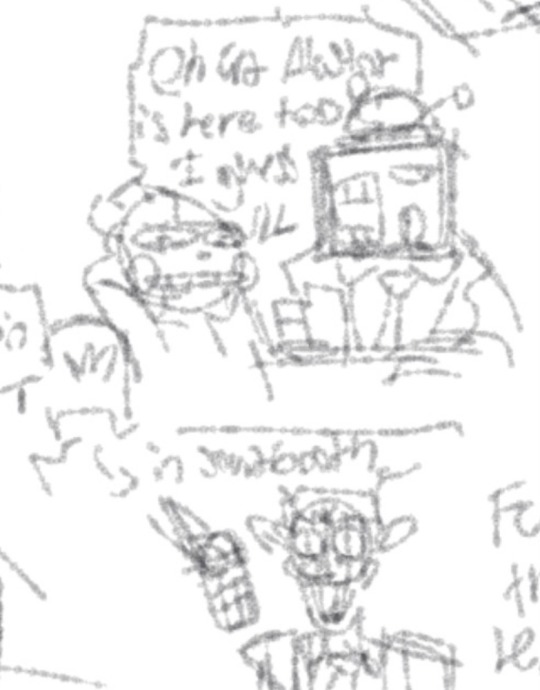
Even though they mutually broke up they still each regret ending the relationship, and as such covey their loneliness in their respective mediums. Vox making sad, gay movies and being so worn out after that when he watches them he doesn’t even know what he made.
And Alastor having a late night audio story about a turtle and a hare going on adventures. There are times where he’ll just start describing crushing regret and isolation, and he’ll realize that he may have gone a bit far and try to steer it towards more of a happy ending with Vox listening in on all of it.
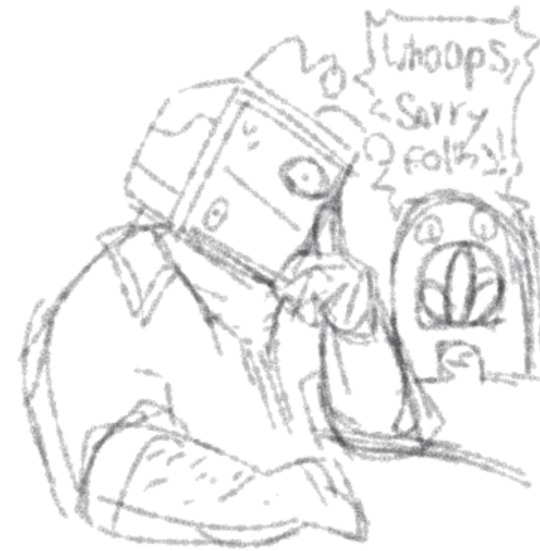
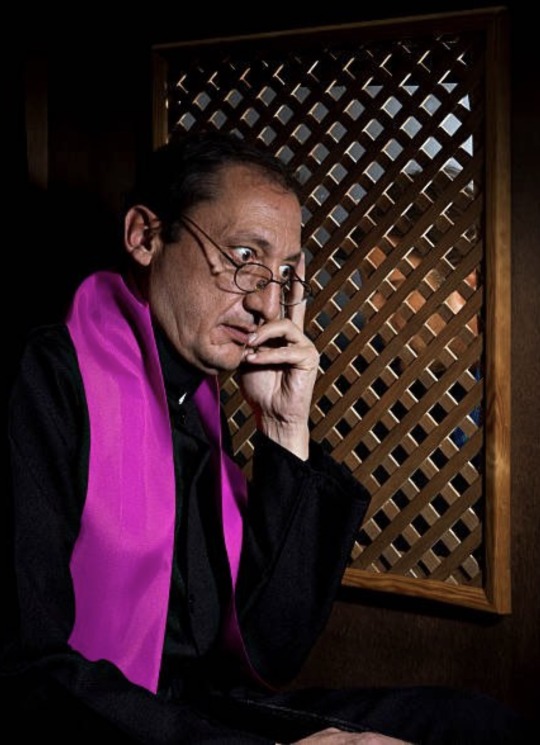

Something something relationship meme with a sketch I’ll probably never finish. Also surprising, but also not that surprising, to me that in "Stayed Gone" they didn't go with the obvious joke on what to call his late night talk show.
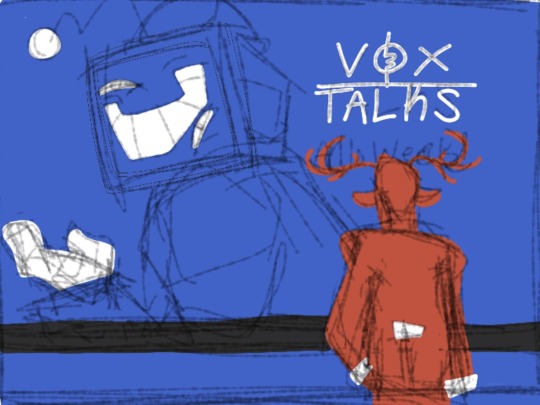
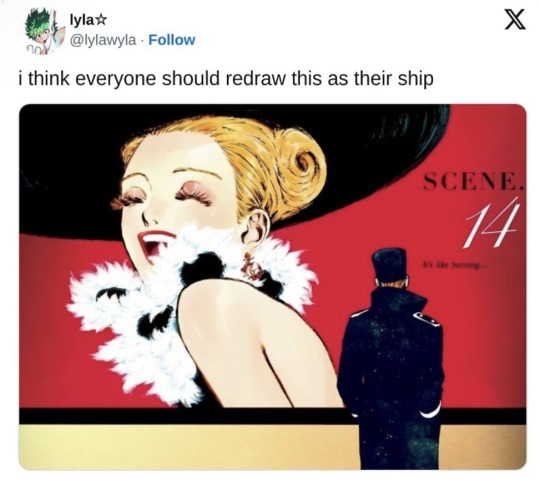
The grrls r fighting!! But for real this time.

Been playing with the idea of Vox turning into pure energy when he's overly stressed, or just becoming a weird robot creature as form he can take as an overlord. It's probably going to result in a lot of sketches where I 𝘵𝘰𝘵𝘢𝘭𝘭𝘺 won't use Videodrome as inspiration (lie).
At some point I need to get a good animation program and just start making a bunch of animatics or animations cause I have so many song inspirations for these two.
Specifically one that I want to make a whole animation for is “(They Long to Be) Close to You.” Basically it’s just going to be them fighting interspersed with moments of them waltzing together. I think you can probably parse out the metaphors and connections I'm going for here.
youtube
Also me and a friend were talking about song inspirations and after I continually listened, watched, and worked (at least for me) on Hadestown we just replaced Hades with Vox in some of the songs.
🚨SPOILERS FOR HADESTOWN🚨
One stanza that I need to make an animatic for is in Chant Reprise, specifically 2:33-3:18 with the “I conduct the electric city” line.
youtube
This is going to become a bit of promotion for the show cause I love it so much. Probably my favorite musical ever! Also highly recommend listening to this version of "Chant," cause there’s a verse for Persephone and Eurydice that provide some cool reflections that reflect the original “Chant” in their verses.
youtube
There’s no direct references to any of the other characters, although you can add your own interpretations.
On that note here’s another song that reflects them. “How Long?” mainly with the “your pity won’t fit in my bed” lines, and when Hades and Persephone are actually singing to each other turning it into being about their relationship instead of the fates of Orpheus and Eurydice.
youtube
And a lil teaser for how they make up:

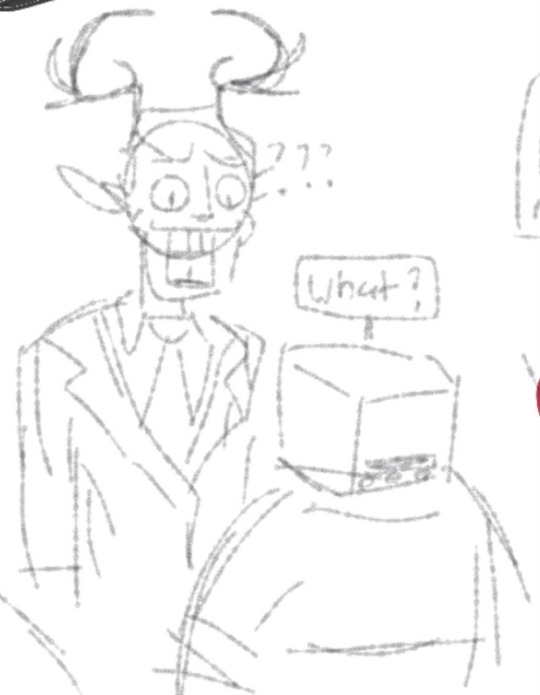
Will make another post about them. I have so many sketches WWHYYYYYYYYYYY!!!!!!!!!!!! I CAN’T ESCAPE EITHER VERSION!!!!
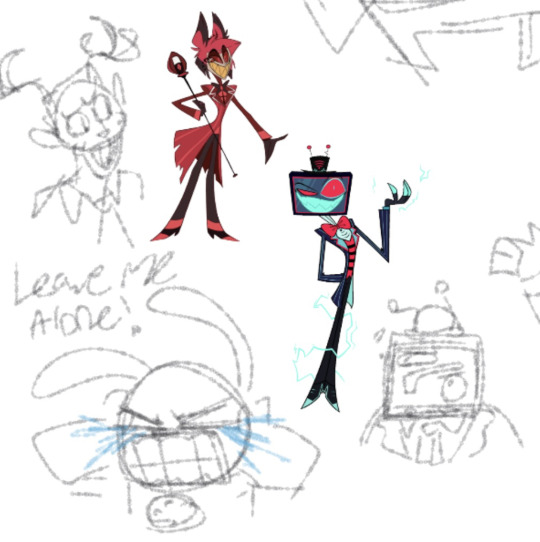
#vox#hazbin vox#hazbin hotel vox#hazbin alastor#hazbin hotel alastor#alastor#hazbin rewrite#hazbin redesign#alastor redesign#digital sketch#sketch dump#sketch#Youtube
51 notes
·
View notes
Text
I still see the misconception that Vanitas is pure darkness and/or the Darkness from KHUX only sometimes, and that drives me a bit feral as your local Vanitas enthusiast, so for your conveniance I have compiled a handy list of evidence to the contrary. As always, there may be more factors we are not yet aware of, but I still feel confident in the assertion that Vanitas isn’t pure anything.
**Side note, I am fully aware of the fact that darkness is not inherently bad, but it is instead too much of light or dark that causes problems. This is not an ‘uwu i want my baby villain to be light because light is Good’ argument. This is a ‘hey this is kh and the characters are a lot more complicated and layered than some seem to think’ argument.
So. Let’s start with the beginning, shall we?
Well, kind of. We’ll get to khux in a bit. BBS first.
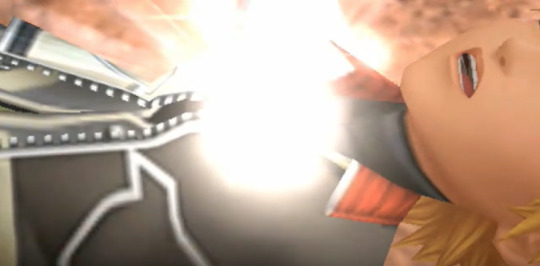
The initial light is easily written off as being Ven’s own light as the split takes place, however;
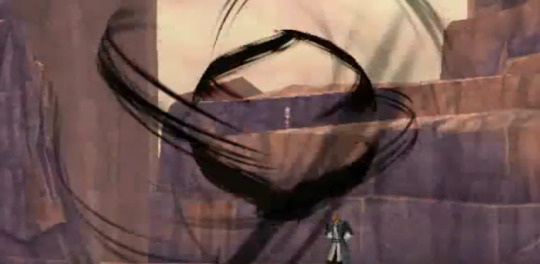
The light continues to rise, right into the ball of darkness that creates Vanitas. honestly I’d say right there makes it pretty indisputable that there is at least a small part of Vanitas at his very core is light.
(edit: as of the kh4 trailer it’s been pointed out that the way Vanitas uncurls and the way the Darksides uncurl as they appear is basically identical. i dont know what that means either in canon or wrt this essay but i do sure think its INTERESTING)
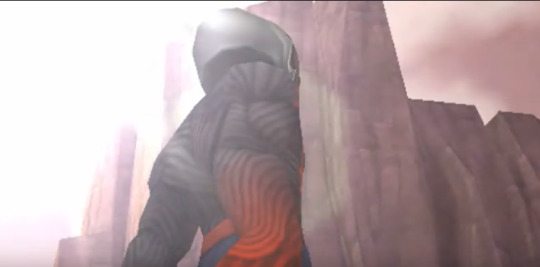
POV: you are ventus about three inches from death looking up at a severed piece of your own heart.
is it visual smybolism or is it Ven’s perspective being too-bright due to his own split related trauma? you decide. (both? both.)
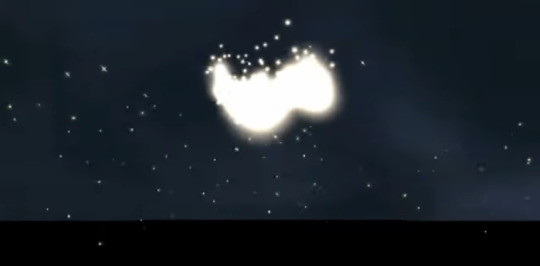
But again, when Vanitas gives up (and yes, he just.. gives up, and it breaks my heart), he turns to light as he falls, just like Ven (who, tellingly, rises instead)
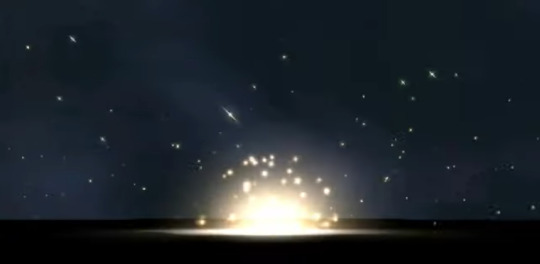
Vanitas’ fall also reveals Ven’s heart station, again by way of a circle of light. I still do not beleive that they completely re-integrated, but I do think it’s a very nice way of showing how they still need each other, despite their divergence.
(whether that need is healthy or not is a matter for debate)
To contrast this, I turn your attention to all the nobodies defeats, and most importantly of all imo, repliku’s.
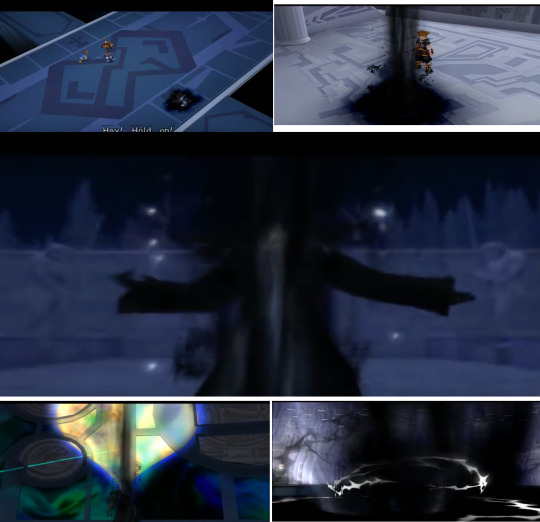
(i do think it interesting to note how many of the nobodies have touches of gray light in their fading too, though some are more noticable than others. They’re all a little bit unique, which I like. i could definitely metaphor on main on these guys if i wanted to. except luxords. which is totally black? for some reason? hey luxord what is uuuuuup)
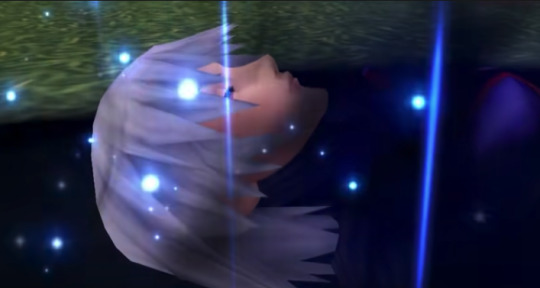
Anyway, repliku. who also fades with darkness, and a little bit of blue lights (which along with purples seem to often be like, darkness tangential, presumably for visual design/contrast reasons).
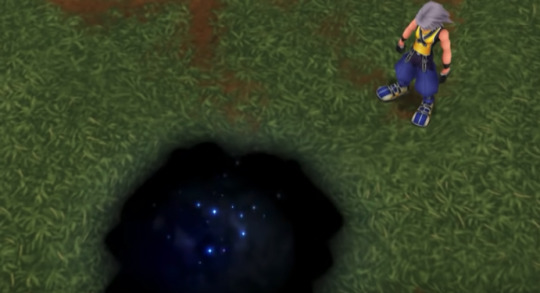
It’s important to note here that the GBA version came out in 2004, and the PS2 remake in 2007. BBS was released in 2010. There was visual precedent for a darkness based non-nobody character fading out of existence, and they tellingly did not use it.
Okay, so what about Xion then?
Xion is pretty solidly light based imo, which makes sense considering how strongly she is connected to Roxas (who is basically light incarnate going by kh3 lol) and sora (who is also pretty strongly connected to light), as well as memories of kairi (PoH) and riku (light cloaked in darkness).
and also there’s the whole ‘memories erased from existence’ thing. I can only assume that fucks with like... everything.
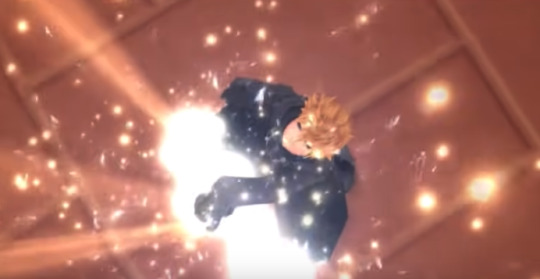
in kh3 we see repliku fade again, this time a mix of his current and past selves which... is a mix of light and dark.
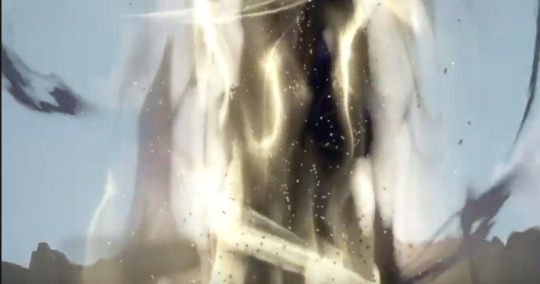
So there’s plenty of examples of characters fading with darkness attached to them, which begs the question.... why not vanitas? The character we are told over and over again is only darkness?
As MoM told us, the truth is what we see, not what we hear.
Which means the answer is that he isn’t.
He’s definitely part darkness, that much is without question, even without the presence of KHUX’s darkness (which i’ll get to in a second), everybody has darkness in their hearts whether they like it or not, with the sole exception of the Princesses of Heart (and possibly ventus. maybe. given the conceit of this whole post though i’m willing to bet not as much as we’re told he is).
anyway. KHUX. let’s look at that shall we?
because i think this is where people get confused. Or simply assume that the previous lore is being retconned. while kh can and does occassionally retcon things, it rarely does so in a way that actively contradicts itself (sometimes it may look like it does, but eventually is shown to only be missing context that made it make sense)
So that being said, I don’t beleive any of my previous points are or have been retconned by khux.
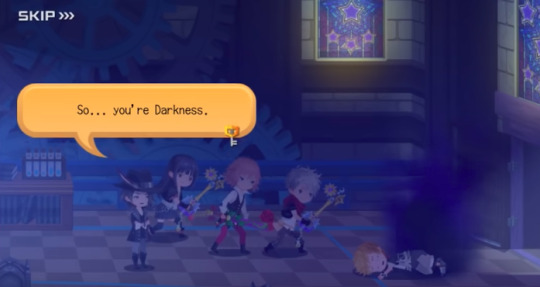
We all know Darkness did a big old possession of Ventus and did a Bad Thing (murder) with him as a host- Ventus himself is a bit of a mystery here since its uh. kind of implied he was a Big Light even before this? and uses that to trap Darkness? kind of unclear. Ven still has some mysteries around him that could certainly turn things on their head again.
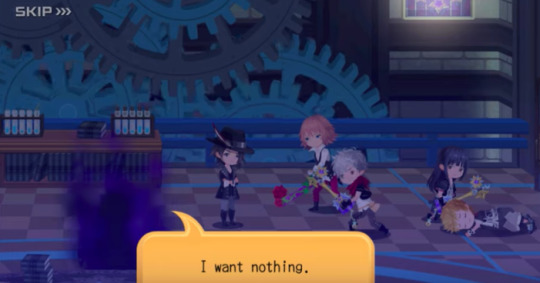
So here’s the thing about Darkness. It wants nothing, MoM says their thought processes are utterly foreign to people, it’s excellent at mind games and lying, and it mostly just seems to do things because it was foretold, no real personal connection to anything. From what we see of Darkness in khux, this appears to be more or less accurate. It didn’t care about OR hate anything about ven, or strelitzia, or anything around them; Ven said he wanted power, so the Darkness gave it to him (in the most Monkey Paw’d way possible).
Look at this, now back to Vanitas, now this, now back to Vanitas, he’s on a horse (yeehaw).
sorry
Doesn’t sound the same at all, does it? Vanitas definitely has a tendency to lie, but that has as much to do with how he’s been manipulated as with an actual concerted effort to do so. A little bit of mind games? sure, mostly with Ventus. Not sure I’d call him great at it or anything. But that’s kind of where the similarity ends, because Vanitas definitely wants things, and he has a lot of feelings- literally so many that his broken heart can’t contain them.
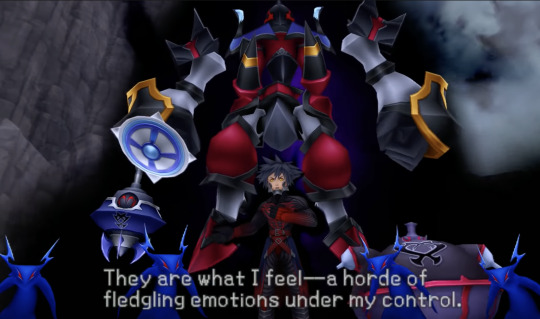
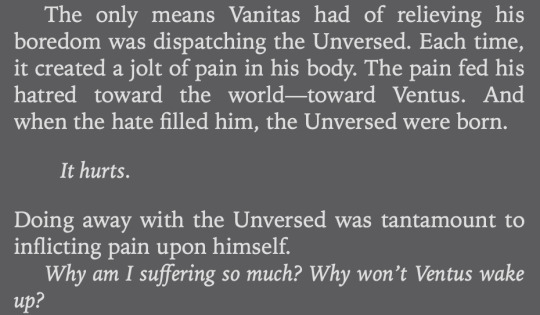
now of course I must mention that the novels are what I would classify as Canon-Lite, meaning that they do occassionally contradict the games, though usually in small, not terribly significant ways. That said however, Vanitas’ ENTIRE conceit through the entire novel is how much pain he is in. Constantly. I find it extremely unlikely that such a major part of the story would be discarded without acknowledgement- maybe in any other series, but not this one. Nomura has outright said that he assigned the writing of the novels to Tomoco because she understands the series in a way no one else does. I also find it unlikely the novels don’t pass through Nomura’s hands to review at some point either. This series is his baby after all.

You cannot read this and honestly tell me you don’t see a child in pain. I won’t beleive you. Xehanort tells him the only way to be free of his pain is to forge the X-blade with Ventus, and from there it all makes sense. Literally every single thing Vanitas does is with that goal in mind, to be free of his pain, and can you blame him? To be in that place, constantly taunted by Ven’s happiness and friendships, told there’s only one way out, constantly in pain and then further abused by your supposed Master on top of it... Is it any wonder a lot of people relate to the abuse/chronic illness vibes?
All of which to say none of that sounds like the Darkness of KHUX. Like... at all.
You know what does sound like the Darkness of KHUX?
This guy.
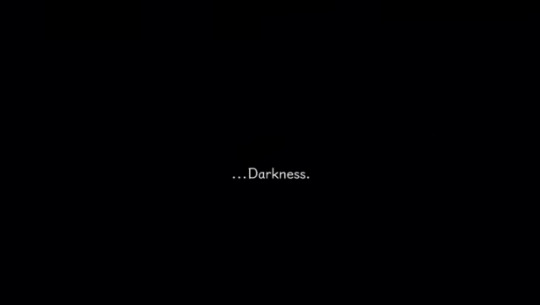
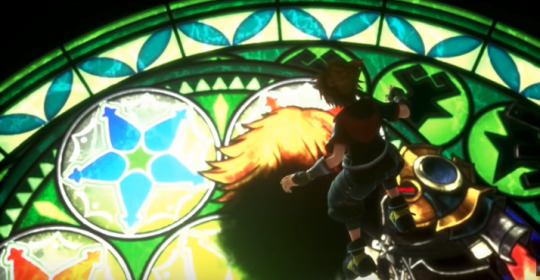
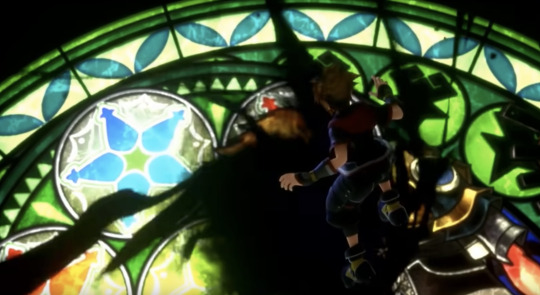
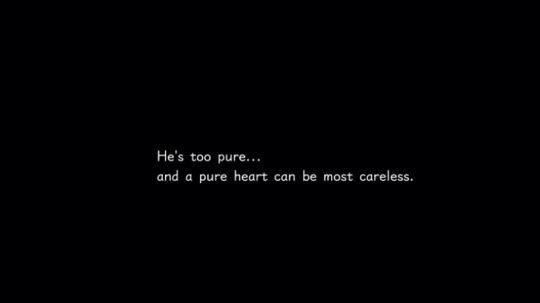
Now, Sora assumes this is Vanitas, and honestly to him this is a perfectly logical conclusion to come to. He’s in Ventus’ heart, which he knows to be connected to Vanitas, there’s a great big dark blotch there, and it says it’s Darkness, which is the last thing that Vanitas told them in the KBG (”What I am... is Darkness.”).
But here’s the thing.
He’s wrong.
Now I’m not going to pretend I did not also have a big “OH MY GOD IS THAT MY SON? IS THAT MY BOY?” moment when I first saw this scene. I very much did. But the more I think about it the more I’m certain that this is not Vanitas, but the OG khux Darkness, and if I haven’t been clear so far, I fully beleive Darkness and Vanitas are two completely seperate beings- ones who have certainly influenced each other, as is inevitable when you share a heart, but are not the same. To say they are I think would be the same as saying the same of Roxas and Sora, or Ventus and Roxas. Namine and Kairi. Xion and... well, a lot of people tbh XD. They are all strongly connected to each other, have influenced each others hearts in so many ways, but are not at all the same.
Honestly even Sora himself seems uncertain of his conclusion, saying Vanitas’ name as a question rather than a statement. It doesn’t really talk like Vanitas either, and the fact that the lines are conspicuously unvoiced (why create a mystery if the answer is as obvious as most people seem to think?) leads me to beleive Vanitas has no part in this interaction.
Which begs the question... Where is Vanitas? How much of his darkness is his own, Ventus’, Sora’s? How have things changed for him since he fell into Ven’s heart, which then fell into Sora’s? I don’t know for sure but...
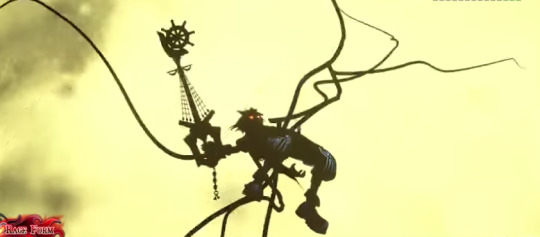
I do think we’re going to find out.
#i had other plans today but i ended up writing vanitas essay's instead#oops#stop talking to yourself flight#kingdom hearts#vanitas kingdom hearts#flight's making things again#kinda? i guess this counts. in a sense#theory
216 notes
·
View notes
Text
NieR and Metaphor
I've been revisiting Nier Replicant with @liketheinferno2 , good God it hits so much harder than I remember. Genuinely been going about my life in almost a daze just like, damn, Dr Taro Yoko PhD really did that all the way back in 2010 and writing in games is still struggling to catch up.
In particular I think the way that it approaches the concept of multiple playthroughs as a way to reinforce its themes in a way that only a video game can shows this most clearly. Even with the first ending, we see Nier being caught in a cycle of wanting to help others, but the only way that he knows how to do this is through violence and self-sacrifice in a way that ultimately destroys himself, harms others, and ironically, harms even the people he was motivated to help in the first place. With his sister, all she wants is for her brother to be with her and spend time with her while she is ill, with however much time she has left. But in trying to "solve" her illness, Nier removes himself entirely from her life, depriving her of the only thing she actually cares about.
With ending D he does the same with Kaine, ultimately removing himself from existence entirely for the sake of someone whose only happiness came from her time with him. At first I worried that ending E added in the remake was just pure fanservice, but it honestly makes me glad that it was added, just to make this point even more clear to the huge number of people who didn't understand it (and I think it goes further than just doing that, but I'm still digesting it).
The idea and mythology of self-sacrifice as a charitable act only serves to obfuscate the ways that it is often deeply selfish and can serve to only bring more pain to the lives of people it was done for. Not only is this just a good piece of writing on a textual level, the process that it takes to achieve this ending forces the player to assume the mindset of Nier. Grinding through the latter half of the game over and over is absolutely grueling. It is often noted that doing this sucks and feels bad. And that's the point! It is meant to feel uncomfortable, because it is a process that reflects the way that Nier puts himself through pain and suffering. Nobody makes him do this. He does it to himself. And, moreover, the act of deleting all of your save data is a perfect encapsulation of a very literal kind of self-destruction through an ostensibly charitable act. All of this works on a character level in the text, a player level as they engage with the game, and from there can be applied directly to real life interpersonal situations. I think all of us either know someone or have BEEN someone who acts the way that Nier does here.
The fact that the reset point is halfway through the game rather than the very beginning is criminally overlooked as a pretty incredible metaphor, honestly, especially for how ridiculously on the nose it is. It is at this point that Yonah is taken away by the Shadowlord, and the point in which Nier transitions from childhood to adulthood. So, let's look at this from the lens of metaphor. Yonah is sick, and is then taken away. We do not see her again after this point until the very end, and have no way of interacting with her. The Shadowlord is quite literally Nier's own soul, which can be taken as a pretty literal version of the Jungian shadow self--the aspect of ourself that we reject and repress. Yonah has been "taken" from Nier, which we can take to mean that either she died or simply grew distant and unfamiliar over time, and this was done by Nier's shadow self, or, in other words, he made this happen through the parts of himself that he doesn't like.
Or, to sum it up:
Yonah was removed from Nier's life by a personification of Nier's own desire to keep her in his life causing him to do things that removed himself from her life. He didn't get to see her grow up, not because someone else took her from him, but because he was so focused on trying to fix her problem that he wasn't around to actually be with her. And now it is too late. That time is something that he will never get back.
Furthermore, we start the game with Nier as a young boy. That is his childhood. The second half of the game is his adulthood. Or, in other words, he was traumatized in his childhood in a way that he carried forward into adulthood. We cannot return to childhood, either for familiar comfort, to rectify the mistake of spending time with those who are gone when we could have, or taking action to prevent that trauma from happening in the first place. When viewing multiple playthroughs as a timeline, effectively what we see is Nier having a traumatic childhood and then repeating self-destructive cycles of violence in response to that trauma throughout his adulthood, motivated by self loathing, trying to kill the part of himself that he doesn't like, culminating in repeating the same mistake of removing himself from the lives of people he loves.
I know we joke and we jape about things cracking our head open like an egg but the perfect aptness of this metaphor combined with how it uses such easily understandable hackneyed jrpg standbys to create it, combined with how few people I have seen recognize it genuinely makes my brain feel like it is dripping out and getting scrambled in a hot skillet.
Throughout all of this though, what is constantly impressed upon us is that Nier is unequivocally a kind person. He is sweet, loving, gentle, and generous to the people he cares about. Where many games go out of their way to paint their morally gray protagonists as gruff and grizzled and standoffish with only small glimpses into the tenderness in their heart, Nier reverses this. Because frankly, in real life relationships this is typically how it goes. I mean, think of your own friends or family members who have done things to hurt themselves or others. Hell, think of the way our society treats public figures who do these things. Our first and primary association with them is what makes us love them. You think of the times that they made you happy and what made you want to have them in your life in the first place. That is the picture we are given of Nier. But the game is still unflinching about showing the consequences of his actions. Ultimately we are left to simply grapple with the fact that people we love, people who genuinely mean well and are motivated by a sense of generosity and justice are still capable of doing terrible things. And, similarly, the people we hate and commit our energy to fighting also have rich lives with meaningful relationships, things they care about, pain they carry, and people who depend on them. Moreover, it is Nier's own desire too see the world in stark black and white, good versus evil, that leads him to commit many of his worst actions. That is a fact of life that makes it complex, and we simply have to find a way to come to terms with.
Going through those playthroughs is uncomfortable because you know that you are causing harm to shades who are fully sentient, you are doing things that lead to people getting hurt, you are dooming the human race, you are hurting Nier and the people around him, and you are probably making yourself miserable through the hours and hours of grinding through combat that let's face it kind of sucks. What I find perhaps most notable and impressive about this, though, is that even with this in mind, unlike most games who tackle similar subject matter, this game does not indict or condemn the player for engaging with it. This is not a moral message about how it is bad to engage with the content and systems of this or any other game. This is a story that wants to communicate its message through play. What it has to say is not a judgment on the player, it is a reflection of a very human experience. Playing out that experience expresses things about it and makes players feel it in a way that non-interactive media cannot.
Because the act of pushing forward through all of those playthroughs is something we must intentionally put effort into, and it is unpleasant, and the endings we achieve by putting ourselves through that wringer feel so unsatisfying, it invites us to reflect and consider what this means for the way that we live our lives and relate to others. Because, crucially, most players aren't doing this out of some general sense of wanting to see more of the game and get more content out of it. It feels bad, but the reason people do it is because there is something motivating them to. The game gives us that motivation, not in something that it gives us in game, but in the form of us as players wanting to save Kaine because she is a character we love. There isn't even the gratifying payoff of a romance between her and Nier. This is something players do purely because they like her and think that going through all of this is worth it if it's for her. In that experience, the player is inhabiting the same headspace as Nier himself, as well as anyone we may know who does things that they know on some level are wrong, but do so anyway out of a motivation towards something they feel makes it justified and worth it.
Some things you can't learn simply by being told, even if you understand it and agree with it on an intellectual level. Those are things you can only learn by making mistakes or doing the wrong thing, realizing it, understanding it, and changing accordingly on a personal level. Nier is a reflection of that, and an opportunity to have that experience as a player in a way that is more direct and personal than if we passively watched a character do it in a novel or a movie. Not only do we get the opportunity to intentionally make that stupid self-destructive choice through play, crucially, the game gives us the motivation to do so. This puts us in the shoes of what makes someone do this, so that hopefully we can recognize it in ourselves, the people around us, and in our society.
And this is only a few of the layers of the themes at play! Because the writing also gets into a lot of stuff surrounding this behavior--themes of neglect, exploitation, the way that self-defense can rapidly become a flimsy excuse for hatred and aggression, and so on. All tightly wrapped into both the cast in-text as well as the real world on an individual and social level. It is a beautifully crafted piece of writing, and I hope that over time it is given the credit it is due.
#nier#nier replicant#nier remake#writing#quality content#I think this is also why I haven't been very motivated to play Deltarune part 2#because undertale and deltarune cover similar themes of cycles of violence and the harm caused by being unable to let go#and I am just emotionally exhausted on that front#and I just don't want to get caught up comparing the two#when I would prefer to enjoy each on their own merits#not to mention interpreting what each is saying specifically without getting the wires crossed#op
153 notes
·
View notes
Text
i personally love the changes they made to norman's character from tcolh to mde, and i don't think that because 'mde's a better game than tcolh' i just like him more in the remake because his character is more fleshed out and at least for me it's easier follow him and the story itself with how his dialogue was changed and reordered. mde is very theatrical and that's probably what makes it easier to follow, it's like a damn movie but hell in some scenes tcolh's seriousness would've been handy but anyway. the way they made both tommy and norman bounce off each other and fill in the gaps of each other's stories instead of tommy leading the whole thing was a nice touch as well. they really did just make norman a proper character and it's great, like they took norman from tcolh and made him even better.
but i think both versions are great anyway because in both games norman has so much personality and lore hidden purely in his use of sayings/phrases/metaphors. and it's great since he doesn't have much lore we just flat out know.
11 notes
·
View notes
Text
Another post about black Louis
Ok so I feel the need to say my piece about this situation in a long post because I want to clarify a few things. First of all, in the fandom there are two kinds of people who disagree with the casting of Jacob Anderson as Louis. The first, is the downright racist people who have a problem purely because the actor is poc. I have nothing to say to these people. The second kind is the people who's problems stem from the changes that this will bring to the story. I would like to address these concerns and express my opinion on them.
Personally, my preferred option would be to use the vampire metaphor to address race in America. In the book, Louis and Lestat are vampires aka monsters, who own slaves and Lestat literally feeds off of the slaves' blood. Eventually, the slaves (who still have managed to preserve some of their African heritage and cultural consciousness) recognise that their masters are inhuman monsters. There is certainly something here. If Louis were to be, for example, the son of a slave owner with a female slave, his vampirism could represent his assimilation into the dominant white class, as he gradually becomes monstrous in the eyes of the other slaves. What I'm saying is, there is potential in this change storywise. There is, however, something I fear greatly.
There is a tendency in reboots and remakes to erase certain aspects of the story that are deemed problematic without ever addressing them or commenting on them in any way. This is the case with all the Disney remakes, in which racism is completely erased in an effort to make it like it never existed in the Disney company. This, to me, is abhorrent, as it prevents racism from being meaningfully addressed and commented on. If the new adaptation chooses to make Louis a black man and an owner of a brothel in order to erase the problematic history of white slave owner Louis, I will be disappointed. I believe that there should be space in media for characters such as the original Louis, as long as their behaviour and place in society is challenged by the story. In the original IWTV, even though it is, as I mentioned before commented on, it is, in my opinion, not enough. Also, to believe that a character who owned slaves can never be sympathetic to an audience is to believe that racism and horrible crimes against humanity can only be committed by inhuman monsters, and that is, unfortunately, not the case. Such portrayals reinforce the idea that we, as moral individuals, could never be racist or bigoted. They dehumanise the racists, thus absolving us of the crime of racism.
The point I'm trying to make, is that if the creators of the show mean to make something profound and poignant, they will not avoid addressing racism, or try to soften it's horrors by obscuring them in the story, but rather use the horror genre and specifically the vampire as a way to tell a meaningful story that tackles race in a manner that will challenge the audience. In order for this to happen, the writer's room should NOT just be a bunch of white people.
Anyway, these are my thoughts on the casting of Louis. We'll see what happens.
#the vampire chronicles#vc tv#louis#louis de pointe du lac#jacob anderson#iwtv#interview with the vampire#racism cw
37 notes
·
View notes
Text
My list of bearable Binal Bantasy VII tags is thinning...
But seriously. Being skeptical of Tifa’s narration of past events is not without merit. By the time the Lifestream scene rolls around she has been through three comas and some grevious injuries. The Lifestream scene is as revelatory for her as it is for Cloud.
The new assertion she was in any way actually friends with Cloud is not only in conflict with the OG’s portrayal but counter to Cloud’s development, her development, the growth of their relationship as adults and why (in general) people have them stay together post game.
Its unnecessary, frustrating and further damaging Tifa’s character who is spinning off further from who she was.
That Tifa and Cloud were not actually childhood friends does not mean they do not have a relationship in FFVII. It does not mean they cannot be together. Tifa “falling in love” with Cloud at the water-tower does not for a second make their later relationship any more meaningful.
All this new ship information does is make the relationship have longer longevity than previously assumed. As if whichever relationship has lasted longer is betterer and stronger. As if this should automatically undercut any other relationship Cloud or Tifa can possibly experience.
(in fact - and darkly cynically - this feels a lot more like enforcing that Cloud/Tifa and Zack/Aerith operate in near exactly the same way. The pairs fall in love in record time (two years prior to the Nibelheim incident both times as far as I’m ware), the boys go missing and the girls never move on with their lives. I get the boys have gone missing without a shred of explanation or closure, but now for both of them people are willing to wipe out a quarter of their lives waiting. Teenagers are resilient you know? They will be inconsolable if this happened but they would bounce back a lot faster and cleaner than they would expect. The approval of the never moving on this is purely to keep the shipping uncomplicated. There can only be one pairing for Tifa, there can only be one pairing for Aerith. And if you think otherwise you’re wrong in canon. And who wants to write or read about a non-canon ship? Unless its yaoi/yuri in any case. I am so tired)
Childhood friends incidentally is not, however much some insist, a common trope of the series - unless you stretch it a fair amount and it encompasses a trivial number of the pairings. And none of the big ones (you know; Squall/Rinoa or Tidus/Yuna).
Could Tifa do with more backstory? Of course. Did Tifa’s mother deserve a name? Absolutely! But not like this. Not when Cloud helping round up cats in Remake is now tied to finding Tifa’s cat in a new authored backstory. This speaks again to the constant magpie-ing of existing imagery and moments from older parts of FFVII to feed the present. The retconning in of importance by changing the meaning of otherwise unimportant moments.
Tifa is not and never was under any obligation to like Cloud as a child. She did not bully him, but neither should she expected to involve him in anything she did. I understand the book has muddied this gloriously, but for what effect?
I mean, I know where the desperation to make Cloud and Tifa childhood friends stems from. I know why you want Cloud to have fallen in love with Tifa at like age 5 or something and for Tifa to fall in love with him at 13. And I rail against it all the time that its not necessary. Being first does not mean better.
Maybe I am old, cynical and exhausted, but I kind of like watching Cloud and Tifa grow closer in FFVII. I like watching Cloud and Aeris grow closer in FFVII. I like to experience these things where I can... experience them? I don’t like reading books which assert things in blunt statements that clarify exactly what the writer intended. I certainly don’t have the patience to wait for a later book to clarify what happened on-screen when I have drawn my own conclusions based on my preferences. Especially as this is all contributing to that continued sense that the OG is a smelly, badly designed embarrassment we would rather tiday away for the crime of being graphically inferior (never mind it was championed on its looks on release) and “goofy” (and apparently unable to run the gamut of emotions I remember from serious to comedy, to silly, to tragic, to pessimistic and quietly optimistic and moving).
I’m coming back to this point to stress it - I want to see the relationship growth. Remake gave me that for Aerith and Cloud even if the details aren’t to my taste. First meeting is awkward because hey, random stranger/Cloud is tired. Cloud gets involved and spends more time with Aerith. And the high-five thing is used as a clumsy/awkward/eh but clear metaphor for how their relationship develops over the course of their time together.
To the point that yes, it makes sense for Cloud to want to rescue her. Less sense for Elmyra and Tifa to be “Well they might not vivisect her” and then delay for two full chapters, but the whole thing flows.
And here’s where I get accused of being a fake fan: I don’t like how Cloud and Tifa’s relationship develops in Remake. Flirting. Tifa being mildly fazed by Cloud claiming its been five years. Scared when he almost kills Johnny. Maybe hurt depending on your resolution scene (hey podcast people! No Gold Saucer multiple dates because too expensive? How are there branched resolution scenes in Remake then?). But there isn’t growth. They seem to fit into each other’s lives without worry, bit of flirting, strange super-intense moments jammed into inappropriate sequences (the train roll, climbing the plate, Cloud remembering the promise unprompted, Tifa not actually engaged with Avalanche’s plans). There’s no sense anything has changed between them, the missed five years has done anything to them.
And I’m sure some would take this as proof of correctness. But... somehow Remake is better for realism despite a lot of new clumsy, but this relationship is not dinged for being implausible? No way does that five year gap not seriously impact any prior relationship to say nothing of developing from scratch.
See this was a neat thing about the OG; while Tifa seemed to have an edge over Aerith by knowing Cloud longer, he was in effect meeting them at the same point in his life and more or less starting from scratch with both. Both ships are valid, and even if Cloud is with Tifa come the end, it doesn’t mean he can’t have romantic feelings about both women.
Oh, but Nojima has changed his mind/always intended it this way. And? I can change my mind about liking what he’s written - and my patience and tolerance of Nojima has waned massively since 1997. To the point where his involvement invokes a pained groan from me.
Plus the hilarious attitude that this is from the same people who insisted “the OG will always be there, stop moaning about Remake”. Well guess what? I don’t like Remake and I don’t really want it around. The OG is better.
Yes, Tifa is under-served and sure, it could be clearer about shipping (but the apparent hostility to ambiguity and personal interpretation is deeply distressing. These things can mean something to you and don’t have to mean the same thing to everyone. Interpreting the romancs - again - not a competition).
BUT
I will take the OG version of Tifa where she believed in the cause, where she had friends (again, yes, the relationship between Tifa and the rest of Avalanche is not well depicted, but it was better than actively curtailing it), where she ran a bar THAT ACTUALLY OPENED AND SERVED CUSTOMERS, where she hated Shinra, where she didn’t know how to treat Cloud because she had only really talked to him once in her life and DESPITE THAT that they great closer and spent their last night before THE END OF THE WORLD together over the Remake.
Where Tifa is wary of Cloud for about 5 seconds, twice and then defaults to constant flirting. Where Cloud is near smothering Tifa every second they’re together and she doesn’t tell him to fuck off once. Where she’s allied with Avalanche but hates their methods (and the pacifists are in a shop around the corner and she is not with them because...?). Where she has some absurd contrived plot about medical bills and buying Seventh Heaven for Barret and Marlene.
Which would lead to a whole other rant titled “Marle is the Worst” but this has dragged on quite long enough.
But seriously; if you argue that we can’t hate Remake because OG is always there, then you have to stop applying Remake back to OG and using it as proof. Which is exactly why many people bemoaned the Remake at all. OG is one thing, Remake is another. I don’t care for the latter.
And I know if anyone does read all this it will be about the meanie Cleriths who diminish Tifa for no good reason. And yes, they are indeed acting in bad faith. But what makes you think for a second evidence will convince these people?
In particular, the argument has raged so long and always will because if people do not like a ship they will not accept it as canon (if they care about this as a factor) NO MATTER WHAT HAPPENS. Literally. Look at Loki if you want the most recent example of this.
Canon is to many “what I want” and often does not tally with the general interpretation. And you know, if being “canon” or guessing right early wasn’t triumphed as such a vital thing, we might not get these really terrible and pointless arguments.
Canon is a prize but here’s the big secret: fandom - in general - does not care. FFVII is an excellent case example given Sefikura overwhelms the other ships (and I think AZGSC is close?). And that’s not canon. That’s not even in the ballpark of the Cloud/Tifa vs Cloud/Aerith arena (even give that the former is roughly twice the size of the latter, you already won, so please stop?). Canon is only important if you think its important - and you get some more official art of sequences you can gif. And maybe you get kissing/implied sex/marriage/kids, but most of all you get a smug sense of superiority. And the last is why I have no patience with this.
15 notes
·
View notes
Text
Aerith & Tifa: Visual Design
An Analysis of the Final Fantasy VII Heroines [Part 1]
This is the first part of my in-depth analysis on FF7′s heroines, where they are depicted as perfect foils to one another. For those who don’t know, a foil is a character who contrasts with another and simultaneously highlights the qualities of that other character. Foils can range from protagonists & antagonists to, in the case of the FF7 girls, very close friends. In exploring this particular writing technique, I will examine their differences and similarities, friendship, relationships to Cloud and Sephiroth, and their differing but equally important roles as heroines in the overall story. Before starting though, I want to mention one thing: I adore both characters, and Tifa and Aerith are to me the exemplary role models of fictional heroines.
Now let us begin with the first thing we are introduced to: their visual designs. (Note that visual design, like narrative, is a tool that can be purposefully accurate and/or purposefully misleading. This should be kept in mind throughout the entire analysis, for FF7 - to no exaggeration - gets more than the average game's pleasure out of tricking, subverting and astonishing it's audience.) Now, onto our beloved flower girl...
AERITH
Aerith’s visual design, at first glance, is one of a meek and kindly girl. Her long, sleeveless dress, pearl pink in color, elicits an air of grace, of softness and serenity. She appears gentle and pure. These qualities are enhanced by the matching pink ribbon in her hair, which adds an additional purity to the character – one of youthful girliness, evoking a naive separation from the gigantic world around her.
Accompanying the dress and ribbon is a short sleeve crop jacket. And instead of enhancing this grace and naivety, its crimson shade shows quite the opposite. Red is a bold and brazen color. Coupled with the 90’s crop-style of the jacket, it enforces strength and vigilance. The loud (and somewhat rebellious) qualities of her jacket countervail the quiet elements of her dress and ribbon. They are a contrasting balance, as we will soon find out, of Aerith’s personality. She is gentle and pure, but she is no softie. She has complete confidence in herself.
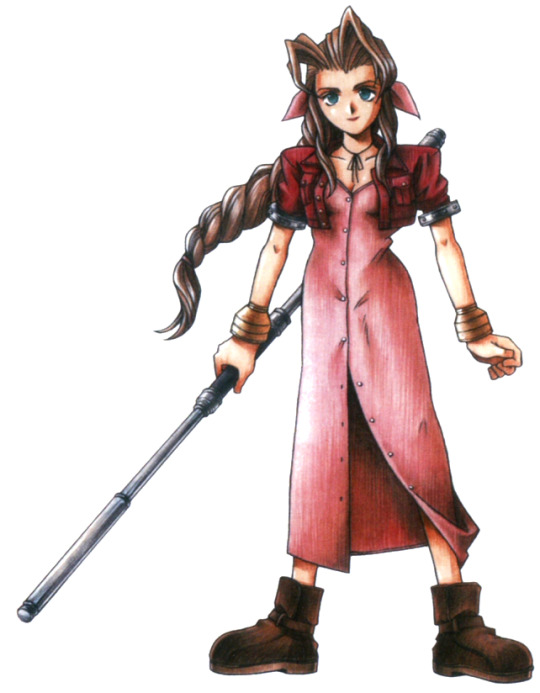
These contrasting qualities are connected in the fact that red and pink are proximate colors. While the dress and jacket themselves are from two different worlds, the colors go together. Moreover, red and pink are the colors that represent love. Mixed together, they create ‘hot pink’ – a color used to communicate playfulness. A beautiful metaphor for both Aerith’s love for all life and her playful, sassy personality.
Moving on to her footwear, we find an even sharper contrast. One would expect that a person who so fashionably marries grace and strength would have stylish footwear to match. Yet here is Aerith with a pair of grimy, commonplace boots. While the dress, jacket and ribbon communicate her nature and personality, these grimy, commonplace boots inform the player of the life she is leading – the life of a girl who has grown up in the slums. These grimy, commonplace boots are the wise and fitting footwear to get by.
Aerith’s boots and hair are the same shade of brown, framing the vibrant personality her outfit presents. In addition to the bright, lively clothing, her hair is a standout feature of her character. And there is another character that shares this feature. Aerith’s trademark bangs share an almost-identical design to Sephiroth’s, an allusion to her in-every-sense enemy foil. Not only do the pair share similarities in their hair, but also in clothing: Sephiroth’s collar parallels Aerith’s jacket; his wrist-cuffs parallel Aerith’s bracelets; his cloak parallels the length of her dress; and his eyes – although mako-induced – are an even deeper green than Cloud’s, in direct match to Aerith’s.
Their bright green eyes further represent their foil-roles in relation to the external plot of FF7 – the plot concerned with the Planet. Aerith’s eyes are green with life, representing her connection with the Planet. Sephiroth, of course, holds a connection too, though his Mako-induced green is not his authentic color, portraying him as the false ‘savior’ he acclaims himself to be, in contrast to the true savior that is Aerith.
To see Aerith and Sephiroth’s designs as directly antithetical to one another, consider their concepts below, with Aerith’s weapon and hair trailing right while Sephiroth’s weapon and hair trails left – like a mirror image. Also, notice Aerith’s bright, vibrant design against Sephiroth’s dark, monochromatic design - a visual display of life and light against darkness. But more on Sephiroth later.
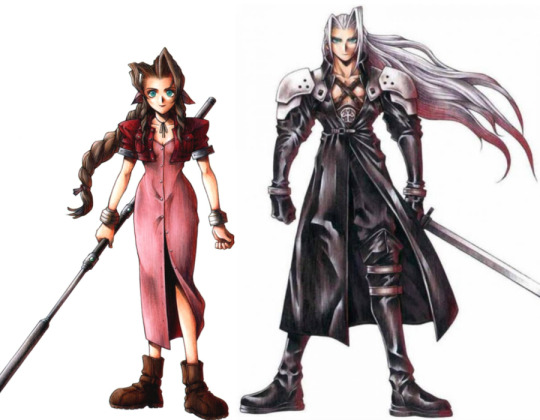
There is no FF7 character with a brighter visual design than Aerith – fittingly, for she is the party’s light. In the remake, her outfit is much the same, if not expanded upon. The jacket reaches her hips rather than waist, and the boots are black, yet about as commonplace as the original brown boots. The notable difference is her dress. The remake fits Aerith in a looser, frilly dress, which actually enhances her grace and creates a more deceptive air of naive youthfulness, much like the longer crop jacket further enhances her boldness.
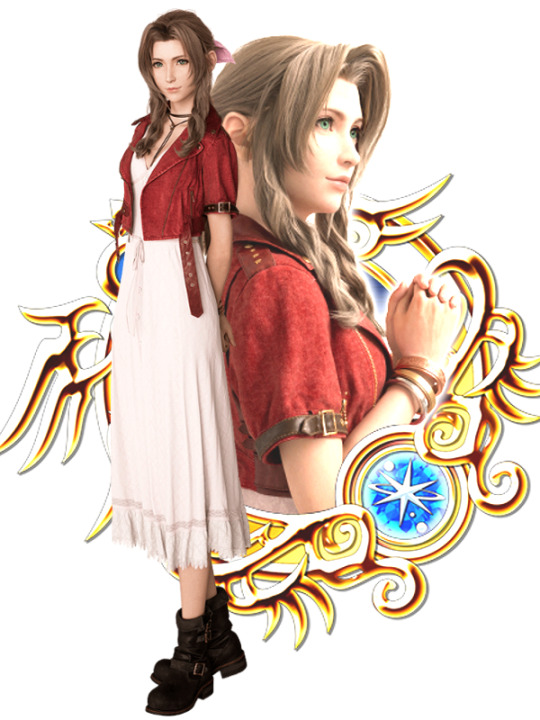
TIFA
There are two roles incorporated into Tifa’s visual design: Tifa the barkeep; and Tifa the monk (that is, a martial artist of FF-verse). We will begin with the former, the first role introduced when the player meets her in Seventh Heaven.
Tifa’s barkeep design consists of black forearm sleeves matching a black skirt that is held up by suspenders. With her hair tucked behind her left ear, a teardrop earring is visible. Immediately, one gets the sense of warmness and invitation they would associate with a hostess. The skirt and suspenders appeal to the sensuous aspect of the design while the sleeve and earring give off an aura of classiness. Overall, an attraction is formed between Tifa and player – that sense of warmness and invitation drawing the player toward her. This attraction is enhanced by her long, dark hair and warm, wine-hued eyes. Not only is the color of Tifa’s eyes a clever nod to her literal bar-hosting, but it alludes to what her bar-hosting metaphorically symbolizes – a nurturing motherliness accentuated by their warmth. Not only is the player drawn in by the clothing she dons, but Tifa’s natural features are what inaugurates the invitation.
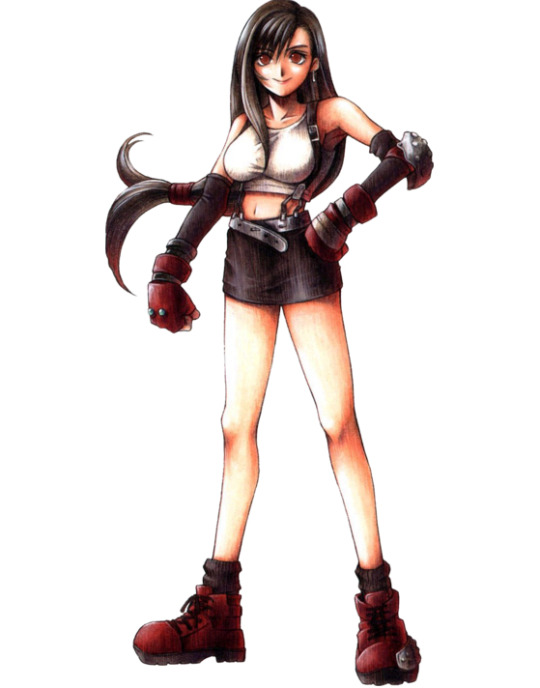
Next is the role of monk. Padded gloves and boots match the dark red shade of Tifa’s eyes, coupling her warmth and hospitality with strength. Strength and its associated qualities – firmness, power, intensity – are usually found in opposition to tenderness. But manifested in these items of clothing that are the same color as the defining embodiment of the latter (Tifa’s eyes), strength and tenderness are bridged together. Tifa is a fighter fueled by compassion. Tifa is a fighter who fights to protect. A matching dark red band ties the ends of her locks together to keep them collected, and on her left elbow and boot are armored guards, enhancing her aura of strength. Finally, she wears an ordinary white tank top for practicality in movement.
Put together with the elements of her bartender design, Tifa’s fighting gear gives her an unconventionally unique appearance: a smash-’em-if-required barkeep; a drink-serving monk. This overall appearance has an appropriate balance between allure and profession. It is attractive without being voluptuous. It is welcoming without hiding the fact that she could easily kick one’s ass if need be. And across her entire visual design, the two roles are in equilibrium. The player is drawn in to her design in the one sense, and then they are let in on what she is physically capable of. In other words, Tifa’s visual design uses its every component to give the player insight on her character. At the same time, however, it purposefully masks a great deal.
Accompanying this ‘smash-’em barkeep, drink-serving monk’ design so centered on conveying its dual-role aspects, are two items that educate the more observant player on Tifa’s circumstances. One of these has already been mentioned and is the classiest element of her design, while the other – which will likely go unnoticed – is the most ordinary. The former, Tifa’s aforementioned earring, is in the shape of a tear, subtly reflecting her past of sorrows and heartache. Yet it is her outfit’s grandest, most expensive item; this past of sorrows and heartache is what enabled her to become strong while remaining compassionate for others. Being a single teardrop on only one ear signifies how Tifa deals with emotions – the emotions she, as her name suggests, locks away in her heart. One drop for herself, the basic remembrance, the fuel, is all she outwardly allows.
Then we have the most ordinary item – a pair of woolly black socks. These socks are so subtle that even the exceptionally observant player might miss them, yet they are the single item that appeals to neither monk nor barkeep. They are distinctly… Tifa – Tifa the ordinary. Every other element is inch-perfect on what it communicates, yet here is a pair of ordinary socks that look as though they were thrown on in a morning’s rush. They give her this every-girl, neighborly quality which the player will be distracted from until the truth comes to light, with Tifa’s centrality and intimacy in the internal plot being revealed – the plot concerned with saving Cloud.
Speaking of literal neighborly vibes and intimacy, it is worth mentioning in brief that certain elements of Tifa’s outfit share similarity with Cloud’s. Both wear two metal guards only on their left side (Tifa on her elbow and boot and Cloud on his shoulder and wrist), a subtle allusion to their being ‘half’-selves on the surface (Cloud with his Zack-delusion and Tifa with her hidden feelings). Cloud too wears an earring in his left ear – a studded one, signifying, like Tifa’s teardrop, a certain brokenness of self. In Advent Children, both wear a black sleeveless vest with a high zip collar, a black cape, black boots (notice that Tifa has now replaced her trademark red) and a wolf symbol (on Cloud’s badge and Tifa’s ring) – a symbol associated specifically with Cloud. I mention these details because of Cloud’s centrality to Tifa’s story and vice versa, which will later be discussed in her role as heroine.
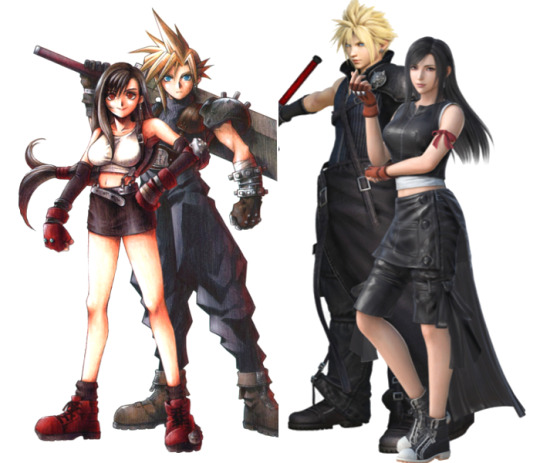
Tifa’s design for the remake is a nice though slight variation that fits in with the more realistic aesthetic. Her skirt has pleated segments, making for more realistic movements during combat, and her abs are toned, further enforcing her strength and perseverance in protecting her loved ones. Her black thigh-highs are an additional element, complimenting her forearm sleeves.
Despite the subtle, throw-‘em-on-in-a-hurry socks being foregone, Tifa’s remake outfit perfectly balances her barkeep and monk roles. The omission of such a neutralizing feature works even better with regard to Tifa’s character, in my opinion, for her true thoughts and feelings will be hidden for much of the game. Thus we are led astray, and the narrative will constantly push us further and further away from her inner emotions hidden beneath these two outward roles.
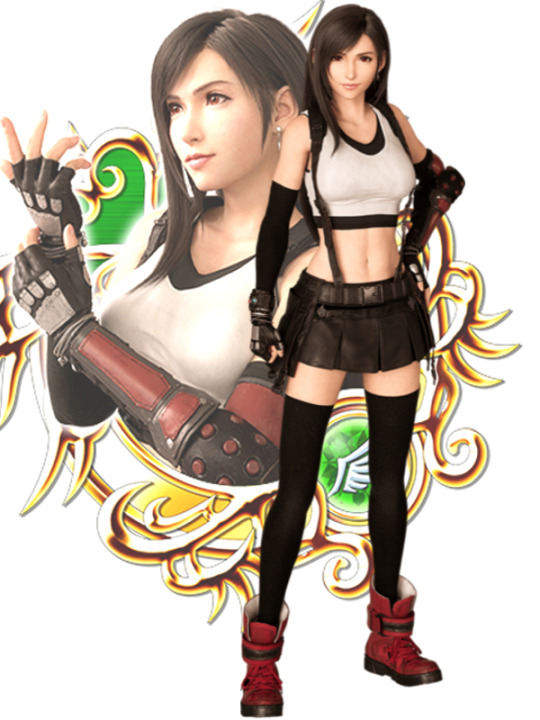
By visual design alone, and in the narrative that will follow, the player is led to believe Tifa has complete confidence in herself. But appearance of course, like narrative, can be deceiving.
SUMMARY
Straight away, by visual design, we have two heroines who are each a blend of multiple characteristics, yet not fitting a particular trope. They are completely unique in their own right, exemplifying both relatable and admirable traits.
Aerith, who we expect to be the meek and youthfully naive girl at first glance, embodies an undeniable self-confidence that compliments her kindness. Tifa, who looks extremely confident on appearance, has an emotional shyness masked by two bold outward roles. Aerith is the vibrant light who guides outer world adventure; Tifa is the inviting warmth who makes one feel at home. Aerith bridges the attributes of grace and toughness; Tifa balances the qualities of compassion and strength. While both exemplify these heroic traits by their very design, they are - however subtly shown - struggling slum girls.
72 notes
·
View notes
Text
June 2021 Roundup
It's been a month of highs and lows. Every year my city holds a cabaret festival, and I've seen some truly amazing acts over the years - including Lea Salonga, Kristin Chenoweth, and Indina Menzel. This year's Artistic Director was the great Alan Cumming, and although due to covid he didn't quite get to curate the program he wanted to, the opening night Gala was still a highlight, as was Alan's DJ set at the pop-up Club Cumming afterwards, where there was much singing at the top of my lungs and dancing to pop anthems and theatre tunes. At one point Alan, dressed in a onesie and perched on the shoulders of a man wearing only sparkly short shorts, was carried around the dance floor while Circle of Life blared. Reader, I was delighted.

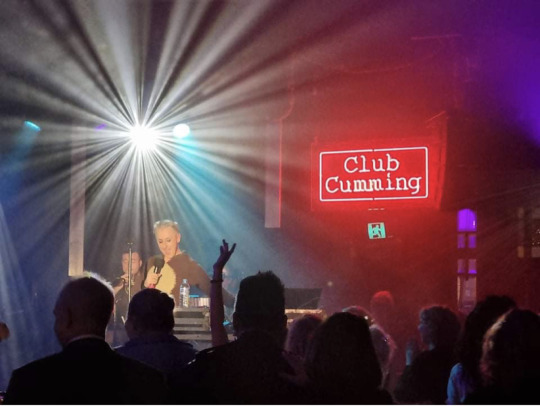
I was also able to see his solo show Alan Cumming Is Not Acting His Age, which was hilarious and damn, he can sing!
As for the low, I was meant to fly to Sydney for the weekend to see Hamilton, a trip I have been looking forward to for almost a year, but had to be cancelled because of a covid outbreak and border closures. The tickets have been rescheduled, but I'm still kind of bummed about it (while completely appreciating the need for covid safety, especially when our vaccine rollout has been completely botched by our incompetent, corrupt federal government)
Anyway.
Reading
The Hundred and One Dalmations (Dodie Smith) - With all the bewilderment over Disney's Cruella, I decided to revisit the original novel which I first read as a kid. It's funny, I had very vivid memories of this book, or rather thought I did, particularly the scene where Roger and Anita have dinner at Cruella's house that fixed in my young mind as utterly disturbing with all this devil imagery and the implication Cruella was literally some kind of demon, which must have been either a) my overactive imagination or b) an illustration, because it's not as clear as I thought it was. The strangeness is there (food with too much pepper, Cruella's inability to keep warm, the walls painted blood red) but not the explicit demon imagery I had remembered. There is a part later in the book recounting the history of Hell Hall and the rumors of Cruella's ancestor streaking out of the place conjuring blue lightening, but clearly child me was reading far more into the book than was on the page.
But I still wish they'd gone with this version of Cruella's backstory, because to me an aristocratic, ink-drinking, heat-obsessed, possibly-demon spawn, high camp villain is more interesting and rings far more true than plucky punk against the establishment.
Smith clearly had Facts About Dalmations to share, and she does really craft a wonderful animal-based story that the Disney animated film is largely faithful to. Key differences include: Roger's occupation (he doesn't have to pay tax because he wiped out government debt somehow?!?), Pongo's mate and the puppy's mother is called Missis, Perdita is another dalmation who acts as a kind of doggie wet nurse, Roger and Anita both have Nannies who come to live with them (Nanny Butler and Nanny Cook), Cruella is married to a furrier (who changed his last name to de Vil). Also odd, on her first description Cruella is described as having "dark skin" but later in the novel her "white face" is mentioned, so I'm chalking it up to 50's descriptors not having the same meanings they do today.
The Duke and I (Julia Quinn) - After being just whelmed by the tv series, I wasn't really planning on reading the books, but I saw this on the top picks shelf at the library and damn, the top picks shelf is irresistible. This is very much Daphne's book (and I had known each in the series dealt with the different sibling) so many of the characters and much of the plot of the show is absent, as are some of the more baffling elements of the show like the Diamond of the First Water nonsense, which I always thought was a strange character choice in that it stacks the deck for Daphne when her character arc is better served as somewhat of an underdog (in her third season, the kind of girl who is liked but not adored), and the Prince subplot which was always far too OTT even for soapy regency romance.
It's a breezy, fun read (that scene excepted), even if the misunderstandings are contrived and I'm never going to take "I'll never have kids because I hate my dad" as a credible romantic obstacle deserving of so much angst.
Faeries (Brian Froud and Alan Lee) - A lovingly detailed and illustrated compendium of Faerie and its inhabitants, drawing from a range of European (but primarily Celtic) folklore and mythology. Froud was a conceptual designer on The Dark Crystal and Labyrinth, and the link is clear in the art as well as the focus on faeries as mysterious but oftimes sinister beings, where human encounters with them rarely end well. Lee has illustrated several publications of Tolkien's novels, and was a lead concept artists for Peter Jackson's Lord of the Rings and Hobbit trilogies, and there is a touch of Middle Earth here as well, or rather the common inspiration of the old world. A useful resource for my novel!
Watching
The Handmaid's Tale (season 4, episodes 4-8) SPOILERS - So when I last wrote about this show in the Roundup, I was complaining it wasn't going anywhere. Well, I'm happy to be wrong because they finally changed things up with June finally escaping to Canada. That part of the plot following the survivors and their trauma has always been far more compelling than Gilead, and so it was a welcome development even if I side-eye some of the choices (none of these characters is seeing an actual licensed therapist why?).
This show has always been difficult to watch given the subject matter, and that has not changed after the shift in power dynamics. I will give the show credit for showing a broad range of trauma responses, from Moira wanting to move on and not let it consume her, to June, a ball of rage and revenge on a downward spiral, to Emily, trying to follow Moira's path but being drawn to June's, to Luke, trying his best but utterly unequipped to deal with what is happening.
But it is very hard to watch June go down this path - raping her husband (I concede the show perhaps didn't intend for it to be rape, but that's what is on screen and framing it as just "taking away Luke's agency" doesn't change that), wishing death on Serena's unborn child, and orchestrating Fred's brutal murder by particulation, then holding her own daughter still covered in his blood and it getting smeared on Nicole's face (an unsubtle metaphor in a series full of unsubtle metaphors).
There are interesting questions being asked of the viewer, and the show (perhaps rightly) not giving any answers. I can certainly appreciate the catharsis of Fred getting what he deserves even if I personally find the manner of it horrifying, but where is the line between justice and revenge, is revenge the only option when justice is denied, when does a trauma release become cyclical violence/abuse - the show is, for now, letting the viewer decide.
Soul (dir. Pete Docter and Kemp Powers) - In a world full of remakes/reboots/sequels, Pixar is perhaps the lone segment under the Disney umbrella committed to original content. However, there does seem to be a Pixar formula at work directed to precision tugging the heart strings, and some of the film feels like well-trod ground. On the other hand, it's hard to criticise the risk of centering a kids film around the existential crisis of a middle aged man, even with the requisite cutesy elements (and of course, the uncomfortable pattern of yet another film where the black lead character spends a great deal of the runtime in non-human form - herein, an amorphous blob or a cat). But the animation is stunning, it successfully did tug my heart strings, and the design of the Great Before and the Jerrys is original and fun.
RuPaul's Drag Race Down Under - Drag Race is somewhat of a guilty pleasure for me, since I generally don't watch reality shows, and this is something I really enjoy even if I'm not invested in the fandom (which like many fandoms can be very yikes). This year it was time for the Australian/New Zealand (Aotearoa) queens to show their stuff, although it's been met with mixed reactions. Covid restrictions didn't allow for guest judges, relegating them to mere cameos via video calls, and its clear that Ru and Michelle really don't quite get all the cultural nuances - Aussie judge Rhys Nicholson was however always delightful. But it wouldn't be Australia without a racism scandal, with the great disappointment of the two queens of colour eliminated first, and one queen having done blackface in the recent past yet making it all the way to the top four.
In the end, the only viable and deserving winner was last Kiwi standing Kita Mean, and it was pure joy to see her get crowned. I do hope they fix the bugs and indeed do another season to better showcase AU/NZ talent.
Writing
A far more productive month - to try and get out of my writing funk I had a goal to try and write every day, even if it was only 100 words. While I didn't quite achieve a consecutive month, I did get a pretty good average, at least got something posted and two others nearly there.
The Lady of the Lake - 2441 words, Chapter 4 posted.
Against the Dying of the Light - 2745 words
Turn Your Face to the Sun - 1752 words.
Here I Go Again - 1144 words
Total words this month: 8082
Total words this year: 35,551
#personal#long post#roundup#june roundup#reading watching writing#here's to the second half of the year#I really want to get to at least 100k written#so we'll see
3 notes
·
View notes
Note
I've been laughing for a solid 10 minutes at your reply (newbie gal). You're a gem, really. Ah! So interesting to know there's a whole term for whatever feels watching Lee jungi's magnificent jawline getting bruised ignites in me. WHUMP! So tell me. What qualifies as the best angst for you? High stakes, torn between love and duty period piece edition? Melodrama level angst? Supernatural 'this person makes me human' angst? Whaaaa?
Hey newbie gal! I’m glad you enjoyed my attempts at humor hahaha.
Ah, I should have known you were a fan of LJK when you asked about whomp. He is afterall, the king of whump.
Are you sure you’re a newbie to dramas because all of your angsty scenarios seem pretty high level fangirl to me. Hmm, I do love a good torn between love and duty period piece. The Rise of Phoenixes still destroys me. Any kind of angst that is high stakes angst is good to me. My least favorite angst is the manufactured kind that does not make any sense within the story and serves no purpose except to make the characters miserable.
The angst of best friends/lovers turned to enemies because of external circumstances is also great to watch. But the reason for turning to enemies has to be a good/compelling one. If it’s purely because of a love triangle/the friend likes his friend’s girlfriend like in Iris - boo, snore, not interested. A good example would be the arc of Shunji and Kang To’s friendship in Gaksital. Yeah, Shunji went a bit one note crazy villain there at some points but they were still able to make you feel for the deterioration of the friendship between the two best friends at the end, which is quite impressive.
I also love angst where the male character screwed up in the past and has to grovel and beg for the female (or male) character’s forgiveness. Like that moment where they realize they really fucked up a good thing and they cannot live without their otp who rightfully wants nothing more to do with them. Oof *chef’s kiss* I love a good groveling scene hahaha. And if the otp can’t help but still love them even against their better judgment so it’s a struggle between pride and love, even better! The scenario that fits this type of angst that comes to mind is Oska and Seul from Secret Garden. I think I might have liked that pairing more than the main one. There’s also New Tales of Gisaeng starring Sung Hoon. I haven’t personally seen that one but I know he’s a real dick to his otp and then spends the entire drama groveling to her and trying to get her back.
But I think my favorite kind of angst is the kind where it’s inevitable and there was nothing the otp could have done to prevent it. The kind that really stabs you in the gut and twists it a few times. It’s heartbreaking because you as an audience can see it happening and where it’s going to end but there’s nothing the characters could have done differently. Not necessarily a bleak scenario but more like a heart wrenching one that really packs a punch because you really cared about the characters and what happened to them. I’m thinking like the ending to the 2002 jdrama A million stars falling from the sky starring Kimura Takuya and Fukatsu Eri. Now this is very old school dark jdrama melo so there are lots of overt symbolism and dramatic metaphors. But I still love it so much because it was one of the few times Kimutaku played a different kind of role and was actually allowed to acknowledge his sex appeal and use it for the character. Without spoiling too much, it’s about a pair of lovers who find each other and save each other but it’s also that love that dooms them in the end. There was a kdrama remake a few years ago starring Seo In Guk but I hear they took out a lot of the bite to the ending.
1 note
·
View note
Text
Brooklyn Nine-Nine’s Funniest Guest Cast Characters
https://ift.tt/3oTakdX
Warning: contains Brooklyn Nine-Nine spoilers.
Brooklyn Nine Nine is one of the funniest sitcoms around thanks to its fantastic ensemble cast and just-broad-enough humour blended with almost-realistic cop show elements. But that great regular cast are supported by an equally brilliant array of recurring characters and guest stars. In this list, we’re celebrating the funniest of the show’s less often-seen characters, those guest appearances who’ve turned up once or twice to inject a fresh burst of comic energy into the show.
Note that we’re not counting regular recurring characters like Adrian Pimento, Madeline Wuntch, or Kevin Cozner, aka Mr Raymond Holt. If they turn up more than once a year, or in more than three episodes in one season, they’re off the list.
12. Adam Sandler, played by himself in Operation: Broken Feather, Season 1, Episode 15
Adam Sandler’s appearance as himself in Season One is beautifully self-deprecating as well as funny. His deadpan delivery of “I’m a serious person” is hilarious in just the right way – of course the real Sandler is, presumably, as serious and as complex as anyone else, but he knows his own public persona and just how to play on it in the right way to raise a different kind of laugh. The interest in antiquities, the planned film about the Russian Revolution, it’s all funny – and somewhat undercut, even more amusingly, by his taunting of Jake straight afterwards. The whole scene did help to flush out a criminal though, so it wasn’t a total loss for Jake.
Funniest moment: Admitting his “serious” Russian Revolution film features Kevin James as Trotsky, and a wife who doesn’t wear a bra through the whole film.
11. Geoffrey Hoytsman, played by Chris Parnell in two episodes in Season 2
When Jake’s lawyer girlfriend Sophia uses her boss as a transparent excuse to break up with him (by going on ‘pause’), Jake wilfully misunderstands and decides that the boss is the key problem, so he sets off to make the man like him. It all goes horribly wrong when Jake finds Hoytsman snorting cocaine in the bathroom, which Hoytsman claims he was doing accidentally while screaming loudly that Jake is arresting him to the whole room of lawyers. Sophia somehow still ends up blaming Jake – probably because she simply wanted to break up with him in the first place – and Hoytsman ends up returning to take Jake hostage and quite seriously threaten his life later in the season. Parnell’s over-the-top performance as a character who is, of course, high for much of the time, is what really sells the character.
Funniest moment: Sniffing cocaine off his collar in the middle of the police precinct.
10. Jessica Day, played by Zooey Deschanel in The Night Shift, Season 4, Episode 4
Back in 2016, both New Girl and Brooklyn Nine Nine were active Fox sitcoms, so the network decided to do a crossover event in which the New Girl characters travelled to New York City and ran into the 99. Most of the crossover scenes actually ended up in the New Girl episode, but Zooey Deschanel’s character Jess Day did make a brief appearance in the otherwise stand-alone Brooklyn Nine Nine half of the crossover. While the New Girl episode provided a lot more context for Jess’s feelings about New York and her stress level surrounding Schmidt’s mom’s car and the soup she’s carrying, her appearance as an apparently slightly nutty woman who resists Jake’s attempts to commandeer the car is an entertaining interlude during the half hour.
Funniest moment: Insisting that Jake’s oath to serve and protect applies to her soup.
9. Philip Davidson, played by Sterling K. Brown in The Box, Season 5, Episode 14
If this were a list of the show’s ‘best’ guest characters, rather than ‘funniest’, the top ranked would surely be Philip Davidson, played by Sterling K. Brown. ‘The Box’ is a tight, taught bottle episode that takes full advantage of Brooklyn Nine Nine’s hybrid status as both sitcom and cop show, and Brown’s Davidson forms a strong third of a triangle in this three-header with Holt and Peralta. It’s a really strong performance, but given that he’s playing a tough-to-crack murder suspect, not really the funniest, exactly. Still, he gets a good few laughs when appropriate over the course of a really engaging half hour of comedy/cop show crossover.
Funniest moment: When Davidson finally cracks, he cracks hard – his confession is equal parts triumphant, cathartic, and hilarious.
8. Karen Haas, played by Maya Rudolph in Coral Palms Parts 1&2, Season 4, Episodes 1&2
Maya Rudolph has a good line going in slightly weary authority figures (see also: The Good Place). Handling Holt and Peralta while they’re in witness protection is not an easy job and her exasperation at Jake’s refusal to accept his situation is well played. Haas is really funny, though, when she starts bringing her own issues into her official duties, clearly trying to get permission to cheat on her husband from someone, anyone – and Holt is happy to oblige.
Funniest moment: Whoever it is she wants to sleep with is “really young” – something that clearly shouldn’t be funny, but the face Rudolph pulls as she says it is what sells it.
7. Lin-Manuel Miranda as David Santiago in The Golden Child, Season 6, Episode 9
Miranda is marvellously smarmy as Amy’s too-perfect brother, her demanding parents’ favourite, who snubs popular culture and shows off by saving people’s lives (including Amy’s own husband). Amy’s delighted reaction when he’s arrested for cocaine possession and deep disappointment when he turns out to be innocent are highlights, but the funniest scene by far is the dance-off between David and Amy, in which both comprehensively demonstrate that dancing is not among the Santiago family’s many strengths.
Read more
TV
Brooklyn Nine-Nine Remake Series Baffles Internet
By Kirsten Howard
TV
The Best Brooklyn Nine-Nine Episodes
By Alec Bojalad and 1 other
Funniest moment: David thinks elbows should form a bigger part of a dance routine than they really should.
6. Frederick, played by Nick Offerman in Ava, Season 3, Episode 8
Any time we meet Captain Holt’s friends and family, many of whom share his stoic, Vulcan-like demeanour, it’s always hilarious. JK Simmons as his old friend Dillman very nearly made the list, but he was just pipped to the post by Ron Swanson – sorry, Nick Offerman – as Holt’s ex-boyfriend. There’s a lot of crossover between Parks and Recreation and Brooklyn Nine Nine among the cast and crew and Offerman isn’t even the only Parks & Rec alumnus to appear on this list, but he’s probably the one whose appearance most quickly calls to mind his earlier character. The idea that Holt’s ex-boyfriend is Ron F-ing Swanson is just genius. OK, Frederick lacks Swanson’s magnificent moustache (though he has a glorious beard) and he’s even more brusque and stand-off-ish, but he’s a perfect match for Holt, even more in their post-break-up mutual antagonism than we imagine they were in their relationship.
Funniest moment: His straight-faced insistence at the door that they have a “wooden-duck situation”.
5. Mark Devereaux, played by Nathan Fillion in Serve & Protect, Season 4, Episode 14
It’s always funny any time police characters in a cop show visit the set of a TV cop show, and for added meta humour, in this case the actor playing the fictional detective is played by an actor who works on a cop show (albeit as a non-cop character). Phew! That’s a lot of layers of meta. Nathan Fillion’s pompous star who apparently thinks playing a detective makes him a detective is very funny, and it gets better when it turns out that was a ruse to cover up his own petty criminal activity before he folds like wet paper. It’s just a shame we didn’t get to see more of him.
Funniest moment: Devereaux tries turning on the angry detective act from his show to cover up his own crime, only to be confronted with quite a lot more than a “shred” of evidence and fold immediately.
4. Eleanor Horstweil, played by Kathryn Hahn in Hostage Situation, Season 3, Episode 11
We heard a lot about Boyle’s ex-wife over the first couple of seasons, partly because Boyle was still living in her basement, hanging out with her new husband Hercules. We knew what sort of person Eleanor was when Boyle explained that he gets the beach house from December to February. When we finally meet her in the flesh, Kathryn Hahn does not disappoint – Eleanor is surely one of the most purely horrible characters we’ve seen on the show (and yes, we’re including all the murderers). She hits a 90-year-old priest with her car and then destroys Boyle’s frozen sperm, all with no apparent sense of guilt, and she largely gets away with it, too. But she does it all with a perfectly deadpan expression and carefree attitude, each horrifying act funnier that the last.
Funniest moment: She goes further than Jake ever thought she would when she “shoots a hostage” – i.e., throws some of Boyle’s sperm down the drain.
3. Seth Dozerman, played by Bill Hader in New Captain, Season 3, Episode 1
Bill Hader’s screentime on the show is relatively brief, but he is hilarious from start to finish, attacking the squad with every shouted command like he’s firing metaphorical bullets at them. It might actually have been really cool to see the squad try to deal with him as their Captain for more than one episode, with his extremely demanding requirements and very highly strung personality, but on the other hand, perhaps this is a joke that works better in small quantities. Any character whose dying words are “Tell my wife I love her work ethic” is probably a character better enjoyed for a shorter period of time.
Funniest moment: Both heart attacks are very funny, but the first (non-fatal) one just pips it for the sheer suddenness of it.
2. Caleb, played by Tim Meadows in three episodes in Seasons 5 and 6
Jake is shocked to discover his only friend in maximum security prison is a cannibal (though he would prefer to be identified as a wood-worker), having assumed everyone in protective custody was a wrongly accused police officer. Caleb is surely Brooklyn Nine Nine’s best streak of really, really dark humour – not only did he murder and eat nine and a half people, they were small children too. Every reference he makes to his “nightmare” past is sickly hilarious, and gets worse and worse every time, including a reference to his “skin suit”. But he really does care for Jake, even if he still kind of wants to eat him. The sheer audacity of the black humour surrounding this character is fantastic and always funny.
Funniest moment: Caleb shows that he has a softer side when he saves Jake’s life – but he immediately deeply regrets it and would not do it again.
1. Doug Judy, played by Craig Robinson in multiple episodes (one episode or two-parter per year)
Yes, we carefully defined a recurring character as someone who is either in more than three episodes or who appears more than once a year specifically so that we could include Craig Robinson‘s Doug Judy. It’s our list and we make the rules. There’s something twistedly beautiful about Jake and Doug Judy’s tender but tense friendship, even in the early years when Judy is constantly double-crossing poor Jake. The two of them have perfect comic chemistry, and each running gag in their friendship, especially their fondness for swaggering out in a new outfit or disguise, just gets funnier and funnier. Long may Doug Judy continue to turn up roughly once every twelve months to harass his long suffering best friend.
cnx.cmd.push(function() { cnx({ playerId: "106e33c0-3911-473c-b599-b1426db57530", }).render("0270c398a82f44f49c23c16122516796"); });
Funniest moment: Having escaped yet again, Doug Judy leaves Jake a pre-recorded message in a karaoke booth – complete with a full hour of pre-recorded singing for Jake to duet with.
The post Brooklyn Nine-Nine’s Funniest Guest Cast Characters appeared first on Den of Geek.
from Den of Geek https://ift.tt/3kZOKSD
4 notes
·
View notes
Text

yeah that didnt last long LOL
“I... You know what? You've convinced me. There's no way I'm fucking with this shit. I'm nobody's puppet, of course. But this was going to be a little fun we had together. A callback to simpler times. I just wanted to play a game, and you were going to be part of it. That submission box was my olive branch, dipped tentatively and at arms length into the trash furnace of creative potential known as 'Online'. But I should have known better. People think you can run a story like this? This must be just about the stupidest idea anyone has ever come up with. I'll just have to make up the commands myself from here on out. Seemed to work ok for the other guy. “
at least hes sort of self aware that hes doing anything different from the guy he thinks of as a villain
“Plants are basically the ideal friends. They don't constantly question your decisions, or try and undermine your authority, or suggest that perhaps you should try talking about your feelings every once in a while. Plants lie down in the dirt and take it, metaphorically speaking. “
Yeah in case you fooled for a moment, definitely villain
Oh :D at least Terezi seems to be joking and a bit of a foil for Dirk as she can also control the narrative a touch it seems, i hope anyway, so hard to tell with these narrative controlling types
No it seems to be impying that Terezi as a Mind player is on the same sort of narrative Turf as Dirk here, but that this is sort of home base for her, while Dirk is in actuality out of his element in controlling words and narrative
Probably because it has been seen to be a purely mental state in terms of the characters who experience it, and even in Homestuck1 Terezi did have little nods that she was sort of aware of the text
“4ND WH3N 1T COM3S TO TH3 4SP3CTS, OPPOS1NG P41RS 3FF3CTIV3LY D3FIN3 34CH OTH3R ON 4 FUND4M3NT4L L3V3LTEREZI: M1ND 4ND H34RT, T1M3 4ND SP4C3...TEREZI: TH3YR3 4LL TWO S1D3S OF TH3 S4M3 CO1NTEREZI: OR I GU3SSTEREZI: TW3LV3 S1D3S OF TH3 S4M3 S1X CO1NS?“
:DD I somehow feel like I’ve been almost half quoted! lolno
But really I LOOOOVE that its being clearly stated the nature of opposing Aspects, if one aspect is one thing, then it’s opposite simply is not that thing.
12 sides of the same six coins, Easy Peasy, very simple to get
hah yup Dirk’s Homestuck2 Opposite day story is gonna be mostly long rants with smatterings of panels, in opposition to how Homestuck was a lot of panels with smatterings of text
“ For the sake of precedent, I'm saying that we can cloak the visuals entirely and continue with narration alone, replacing the panel with a block of text like this, which we can call a “prattle” from now on. “
yeah Im not doing that lol these are just self indulgent rants
“DIRK: Terezi please stop talking right now.
TEREZI: D1RK HOLY SH1T
TEREZI: W
Terezi stops talking immediately, her mind suddenly free of any and all inclination to take a look at what's behind the curtain. What curtain? In fact, she is quite certain there have never been, and never will be, any objects covered by fabric located anywhere in the storeroom.“
well that was uncomfortable as fuck but still quite in character for the guy who said Plants were the best kind of friend because they didnt fight back.
Give your friends juuust enough free will until it becomes inconvenient to you then force them to do what you want, yeah thats not repulsive at all.
So, theses kinds of abusive behaviours are just inherent to Dirk then, even if simply because he’s just the kind of guy who prioritizes himself and his own comfort and control above others and feels like he can force other people to be and act like the kind of people he wants them be whenever he feels like it, no consideration at all for if they want to do shit that has nothing to do with him or worse, go against him.
“ Terezi stops talking immediately, her mind suddenly free of any and all inclination to take a look at what's behind the curtain. What curtain? In fact, she is quite certain there have never been, and never will be, any objects covered by fabric located anywhere in the storeroom. “
I like how its really hammering it in through all of these references that the exact same outcome would have been inevitable in this scenario no matter who was the author of homestuck, it always would have been a communal work that turned into a story of one mans design, and no matter how good that design would be, one man is simply not the sum of an entire fandom, and if he were, he would be formless and identityless with no consciousness of his own.
“ DIRK: Is there nothing I can say that'd take the weight off your mind?”
you mean is there no thought i can insert into your narrative that would make you stop caring about what you acre about
ohh and now im distracted by juicy lore bits
“ DIRK: We scanned for Sburban technology, so we know for sure this is the right planet. Wheels are already in motion and all that. “
they been scanning for sburban tech on distant planets, so they ARE planning on doing some sort of session, another sort of universe remake, but to what end? you already did that with earth, whats so different about this time you ask?
Well, theyre gonna remake the story (or try to) not just a universe by using or enhancing the sburb tech
That was good :D im excited to see more!
I am however, not excited to devolve into random midnight updates that interrupt my sleep schedule because im too old for that shit and also i have a steady job with regular hours now so i have an actual sleep schedule now (so hopefully thats another thing that Not!Homestuck^2 decides to be all opposite day on...hopefully..)
but ive already ruined that for tonight >.>
90 notes
·
View notes